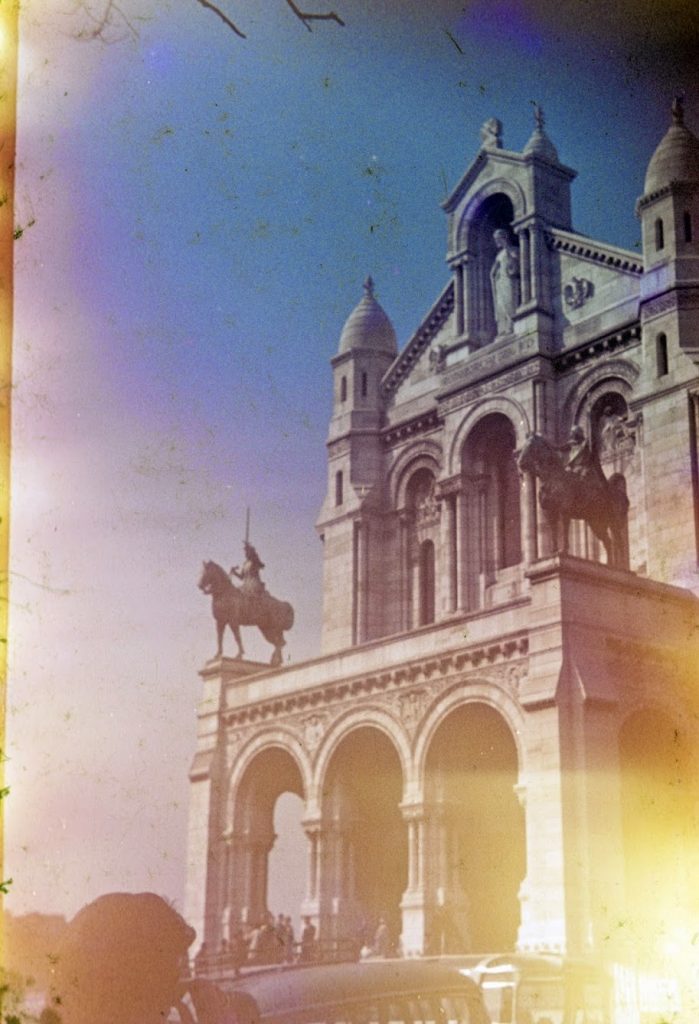

Le Sacre Coeur, Paris 
Category: Travel abroad (Page 1 of 4)
DAY 8

My last morning in Paris. I wasn’t sure if I was going to see Anna. I’d asked her to come over and help me cart my case down the steep stairs of the apartment block but then it had dawned on me that she’d probably had a very late night last night. On the other hand we hadn’t said our goodbyes at the station yesterday. I checked my messages. She’d sent me a video of her scooting through the streets around 1 a.m. so I was surprised and delighted to get a text saying that she was up and would come over to my apartment and go to the station with me. I’d decided to travel back home via train. I’d always wanted to take the train through the Chunnel, something that Anna had done before. She warned me that I’d have to go through a security line at the Gare du Nord so to allow for plenty of time. The train ticket that I’d booked online didn’t mention this fact! My train was at 11:43 and by 10:15 Anna was with me as we made our way to the station. We said our goodbyes. She was to spend the rest of the day with Cez. The security line was quick and efficient and I found a comfy seat and took out my embroidery. This prompted a conversation with a lady around my age waiting for the same Eurostar train. Though French she’d lived in England, Islington, for 30 ears before moving back to France two years ago. Her story was so similar to mine! She now lives close to the Bois de Boulogne.

At first I thought the train was goin g to be crowded. I had reserved a seat and I was packed in at a four seater table but as the train got underway I saw that there were many open seats and so I secured a window seat for myself for the 2 1/2 hour ride to London, St Pancras. It was a dull day with heavy low clouds as we passed through the pretty dull flat countryside on our way to the coast and Calais. The journey actually through the tunnel is only about half an hour and I listened to music for the first time on my trip: a selection of music by French composers associated with my trio: Satie, Ravel, Debussy, and the French-by-residence Chopin. I’m planning to play the c# minor Nocturne next Saturday in Manchester, my first time returning to the Meetup group in 18 months.

We arrived on time at St Pancras. What a lovely railway station . Comfy chairs, clean, spacious, lots of cafes. I ordered some soup and then headed out to try and find the Hop on/hop off bus. I’d thought it would be fun to see the sites of London before heading north. It’s so long since I was in London – maybe the early 1980’s. It took me a while to find the correct bus stop and when I inquired of the driver his route it turned out that he was The Green Line, which was simply a branch of the Red Line, connecting the Red Line to st Pancras and King’s Cross. I didn’t have the time to do what I’d planned yet without it I’d have to spend a lot of time waiting at King’s Cross. I inquired at the station ticket office if I could jump on an earlier train to Leeds with my precooked ticket – but no.
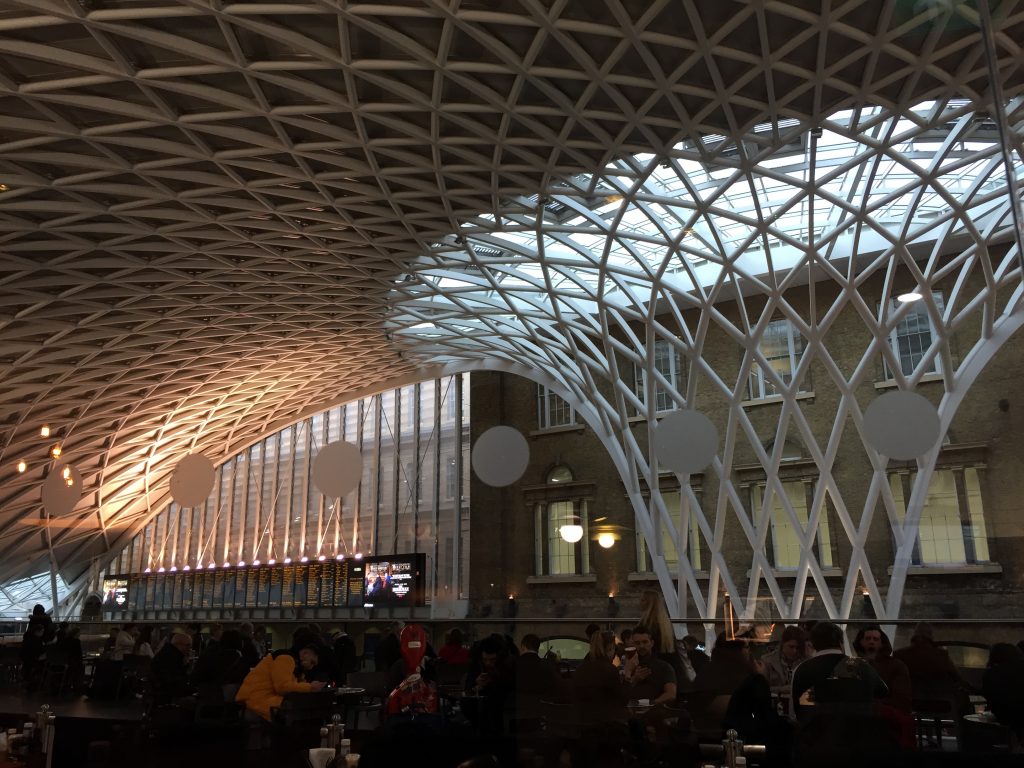
But there was no alternative but to sit and wait 2 hours. I found a comfy spot, admired the architecture, drank tea and wrote my journal. When it came time to board this time the train was packed and I shared my table with a dad and his two kiddies from Wakefield. It was his daughter’s birthday and they’d gone on a birthday trip to London. As we pulled out of King’s Cross I could see the train clock. We pulled out at the correct time – to the second! When we stopped briefly win Wakefield the guard announced that we had to wait for a platform because we’d arrived a little early. “Don’t tell anyone,” he added.

In Leeds I transferred for the 40 minute ride to Hebden Bridge. As I waited on a small waiting room on the departure platform several people were fighting a loosing battle to stop rain water pouring into the waiting from from the platform.

The train was packed and in order to be sure of a seat I sat in the corridor on the pull-down seat. Once in residence I called for a taxi to meet me at the station since it was pouring down, and I was back in my apartment at 8 p.m. after a very interesting 10 hour journey and a truly wonderful, magical week with Anna.


DAY 7
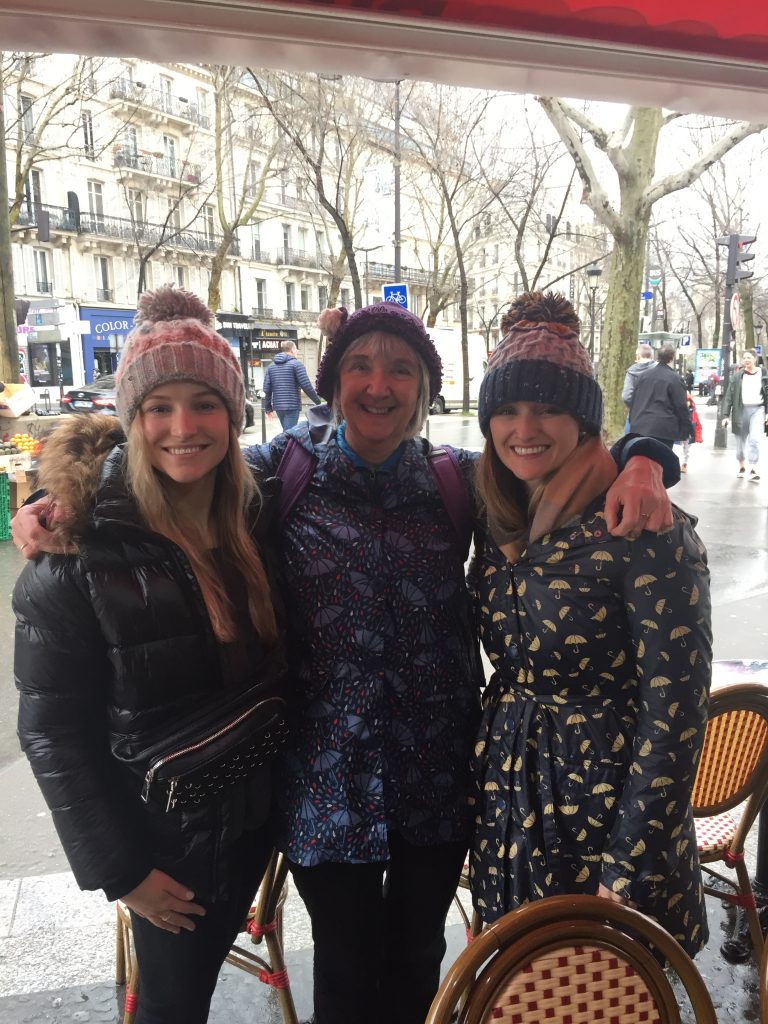
I met Anna and Cez for breakfast. They looked like twins in their similar bobble hats – a comment they told me they often receive. It was so funny because Anna and I were both wearing raincoats featuring umbrellas. They walked with me to Gare du Nord. They were planning on spending the day in Montmatre. I, however, was bound for my first full day adventure out of Paris, to visit the house of Maurice Ravel. As usual I was apprehensive about negotiating the vast expanse of the Gare du Nord, finding the right Metro line, and then transferring to a regular train. However, as usual, once the journey was underway I was fine. The train journey took an hour, rather than the 35 minutes that I had seen scheduled, but I appeared to have taken a stopping train rather than an express. Flat farmland was the order of the day and it reminded me of ‘down South.’ The village is 44 kilometers SW of Paris. I arrived at Gare de Montfort L’Amaury Mere at precisely 2:15 judging by my photo of the station.
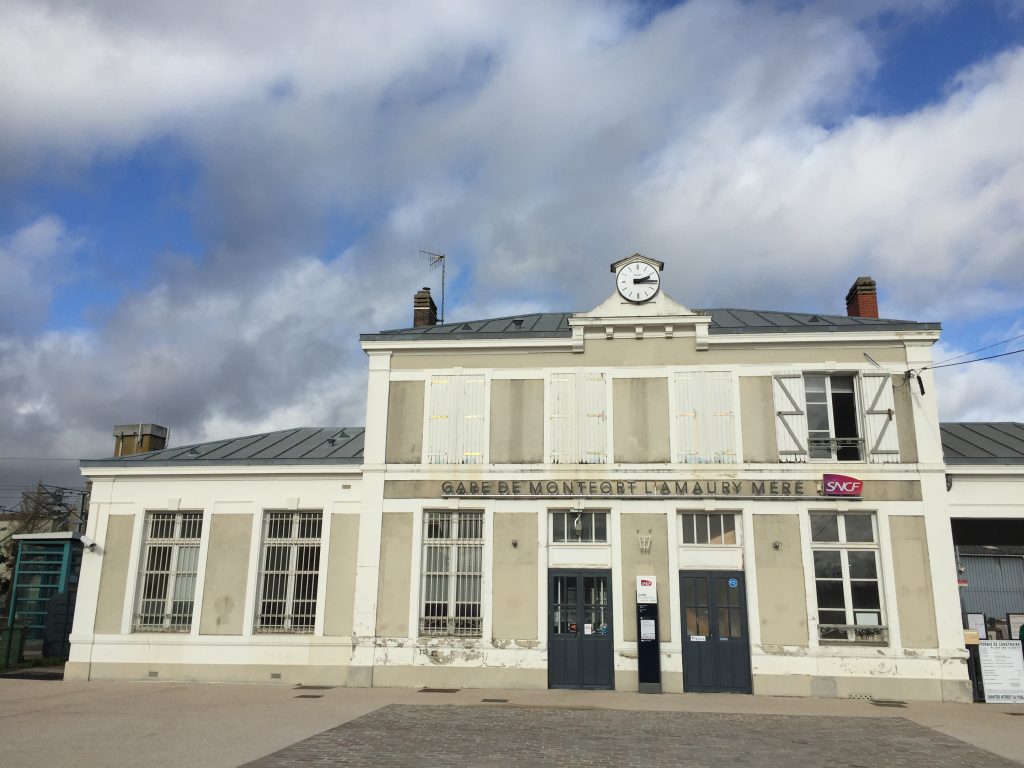
The museum had told me that there were no buses to Ravel’s house from the station at the weekends (!) So I should take a taxi for the 3 kilometer walk. When I exited the station however, I found myself in the middle of nowhere. A few buildings were gathered around the station but no open shops. There was no-one working at the station and although there was a painted sign on the road with the word Taxi on it, there was no such conveyance occupying that spot and no phone number posted close by. I consulted my google map and set off walking but soon gave up at a heavily trafficked roundabout. My tour of the house was scheduled for 2:30. What to do? I decided to search for taxi on my Google Maps Explore feature and found a phone number listed that was only a couple of miles away. I managed to make myself understood, and 7 minutes later a taxi miraculously arrived and whisked me to Maurice Ravel’s house – with 2 minutes to spare. I asked the driver if he could pick me up later but he explained that he’d be off duty by that time but he wrote down on a piece of paper the number of his friend that I could call when I needed a taxi back. Hmm . . .

The door of the house was closed. There were no lights on inside and it felt a bit weird to ring the doorbell but I had no alternative. It was immediately answered by a lady who thankfully spoke excellent English. “Come in, come in. Are you Heather?” Whew. I’d made it.


There were only 5 people on the tour. There’s a maximum of 6 since the museum is really Ravel’s home as it was when he lived there, rather than a museum. We were issued with protective bootees because we would be walking through the rooms and halls on his carpets, not limited to peering into each room through the doorway as is so often the case, such as at the Bronte parsonage in Haworth. The two other couples were French speaking so I couldn’t chat to them but I did get the undivided attention of my guide when she gave me the English version of all that I was seeing. The rooms were tiny, mostly with dark vivid colored wall paint. Stenciling had been done by Ravel’s own hand. His Japanese room were full of Japanese prints and dainty tea cups. His music room has the desk on which he penned Bolero, the Piano Concerto, L’Enfant et Les Sortileges and his Erard piano was next to it. The guide told me that if I was interested in playing it I could apply to the town council and I could schedule a time! That’s a must for my next visit, having played John Ruskins’s and Elizabeth Gaskell’s pianos recently.
The tiny rooms were covered in little gadgets. One was an ash tray that turned into a sculpture of a snail when turned upside down. There were models of birds that opened their mouths, wind up musical toys and lots of games. His father had been an engineer and Maurice had a life long fascination with toys that moved.

I had glimpsed a sign that said ‘no photography’ but I had my phone in hand and I wasn’t prevented from taking a few pictures. I’m always fascinated by the views from windows that creative people have and I took several photos of the views from the windows. The house is on a road that is just above a small village to one side and to the other it lies below a steep hill on which are the ruins of an ancient castle. Ravel had constructed a Japanese garden on the side overlooking the village with the church tower rising above.


His bed was very elaborate and he was very proud of his bathroom with its deep bath. A hot water tank was an unusual item in a house in the early 1900s, as was a shower. Perfume bottles lined the shelves. He lived here alone, never married, though he made proposal of marriage to a close friend. She said she was waiting for a second asking which never came, and so he never married. He commented that he was too shy. On a trip to the U.S he met George Gershwin who asked him for a lesson but Ravel refused, saying he couldn’t teach him anything new. Ravel listened to a lot of jazz and many of his compositions show the influence of that genre.

Wooden houses in the village 
The tour lasted an hour and a quarter and when I left I went to explore the little village, population about half that of Hebden Bridge, with its famous church. The church was open and I had a look round but the only shop I could find open was a bakery where I bought a croissant. I was hungry but every other shop/cafe/bar/restaurant/bistro was closed. Saturday is half day closing! I couldn’t even get a drink. I explored the deserted streets of this little village which seems to be stuck in a time warp and then set about finding a taxi back to the station. Victor Hugo stayed at a friend’s house in the village several times and wrote the “Ode aux ruines” as a memory of the town. I called the number my earlier taxi driver had given me but I couldn’t make myself understood. I talked, someone replied and then I got ‘hold’ music. At least, that’s what I thought it was. But after holding for a while nothing else happened. I tried the number again, got the same ‘live’ person and then again it went to music. Hmmm. I had no idea if a taxi was on its way or not! I waited half an hour unsure how to proceed. And then I saw lights on in a shop. It was getting dark by this time. It turned out to be a shop selling bottles of wine. I explained my dilemma and the server took control immediately and called the number. A taxi would be there to pick me up and take me to the station in half an hour. “Was he on his way from my previous call?” I asked.”No!” I decided to spend the half hour walking up to the castle built in 996 on the hill of Montfort. The town was the seat of the Montfort family from the 11C with Guillaume de Hainaut. His son Amaury Ist (1028-1053), had the ramparts built which you can still see. The lordship of Montfort-l’Amaury was created in favor of the sons of Simon IV (1165-1218). During the war of 100 years the castle was destroyed by the English! Only the donjon tower, built in the 12th century remains. A group of adults, some of the women wearing high heels, were watching their various offspring attempting to climb the ruined walls. It all looked very dangerous, especially since the steep pathways were very slippery. It reminded me of exploring the castle belonging to the Parr family (as in Henry Vlll’s wife Catherine) above Kendal last October.

I headed back down to the town square and within a few minutes my taxi arrived. I’d checked the train times and at this time of day the trains were every hour. I really didn’t want to get stuck at the station for an hour. It really was in the middle of nowhere. I got in the taxi. “Vite!” I said pleadingly, “Vite!” I realized that I didn’t have any change less than an 50 Euro note and when we had ‘vited’ it to the station I saw that the charge on the meter was 12 Euros and 80 cents. I think the driver picked up on my urgency and he threw 40 Euros back at me and urged me to ‘Allez.’ I ran under the underpass onto the far platform and in about 30 seconds the train arrived. Another Whew moment. The double decker train was just the ticket. I changed metro stations at Montparnasse, another huge station. I don’t know how people with heavy bags, or people with mobility problems manage. There are so many stairways to deal with.

I chose to get off at Gare l’Eau and when I came up from the underground I thought I’d landed in Africa. Dozens of street vendors, mainly selling brightly coloured sneakers, were displaying their wares directly on the sidewalks and the place was teaming with perspective customers. It had been raining on and off for most of the day but now it was raining in earnest. I wondered how Anna and Cez were getting on exploring the city in the rain. Aparently they were now going out to explore the Ober Kampf district. After half and hour back in my room and having a much anticipated cup of tea I headed out to find dinner on Blvd Saint-Denis. The rain was coming down by the bucketful just as I left my apartment and I was tempted to go to the first eatery I could find in order not to get drenched, but finding that the first two places were fast food places I gave up on that idea and found a lovely restaurant , Chez Louis where I could sit outside yet again, devour Pasta Carbonera and a pint of 1664 while watching the world go by on this, my last evening in Paris.

A photo of a man with an umbrella crossing the street taken from my table became my first watercolor painting that I worked on on my return from Paris. It turned out to be very apt since a week to the day since leaving Paris my town was flooded and I had to spent a night in a hotel since the water at the door of my apartment building was waist deep.
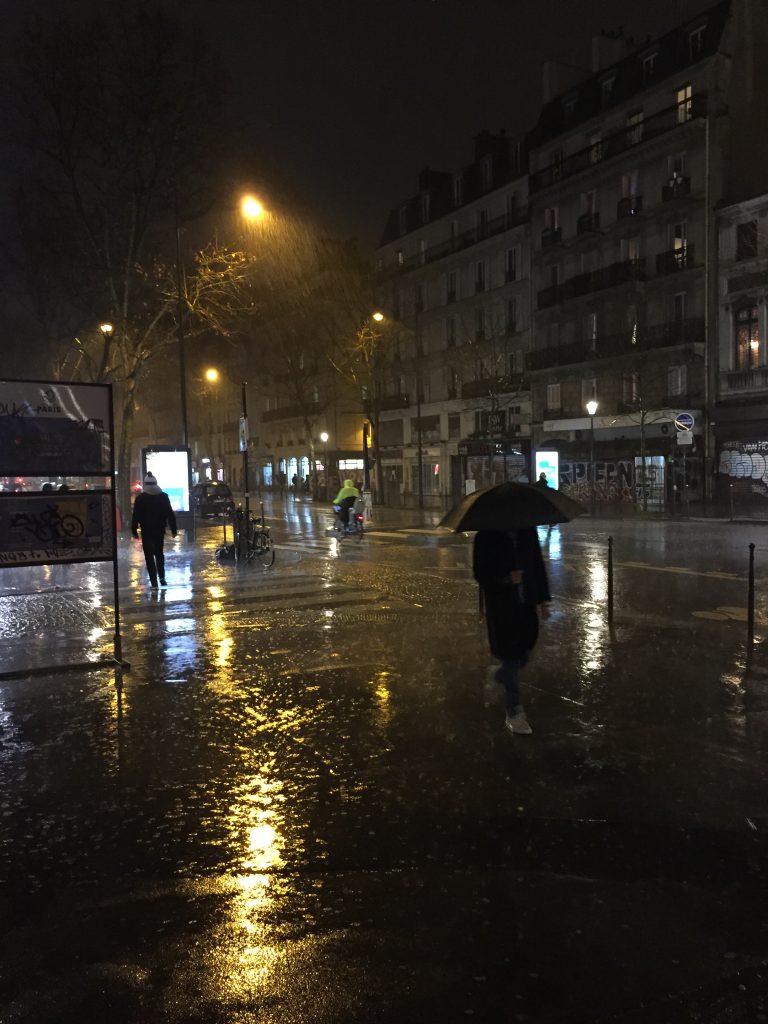
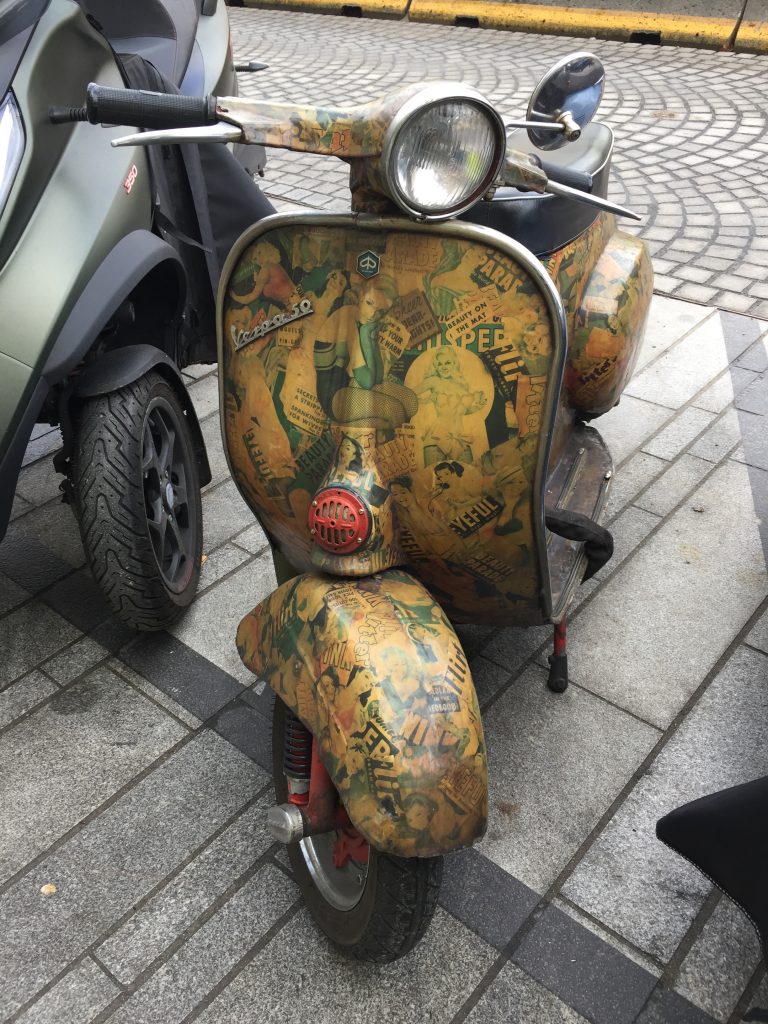
DAY 6
First order of the day was to take my bags over to my Airbnb and check out my new digs. It was only a 6 minute walk over there. My apartment was on the third floor and the well-worn wooden staircase inside the block reminded me of the place I stayed in Sicily. It was quite creepy, but the apartment was fine and gave me a good view of the igoings on in the apartments on the other side of the narrow street.
Anna put on a pile of laundry and we head out to the Bois de Boulogne. From the Metro station the park appeared to me basically an avenue of trees with pleasant footpaths. We were fortunate with the weather and though a bit wet underfoot we had bright sunshine. Eventually we came to an area of activities including a little railway.

My immediate idea was to take the train through the park so that we would know what there was to see.
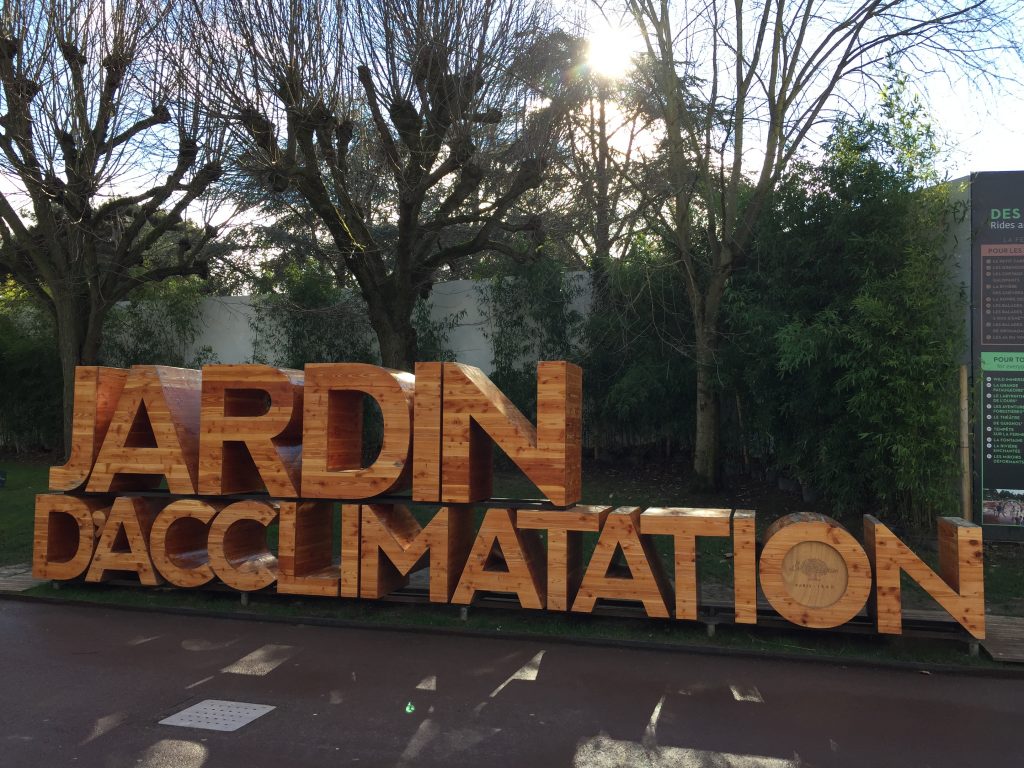
I hadn’t done my homework! But we discovered that the train doesn’t go through the park, it just connects the activity centre in the park to the Metro station. We had lunch at a lovely cafe full of photos of inventors and a lot of their inventions were on display in glass cabinets. It was delightful. Outside a floral clock was full of purple winter pansies.

We headed over to an enormous glass and steel building. It reminded me of the Lowry centre in Salford and the museum of Rock and Pop in Seattle. The other place it reminded me of was the amazing concert hall in Los Angeles that I’d been to at a MTAC conference and with a bit of digging around we found out that it was the same architect, Frank Gehry.
The art museum opened in October 2014. More than 1million 400,000 people visited the Louis Vuitton Foundation in 2017. We didn’t go in because we wanted to see the other attractions in the park but it’s definitely on my ‘must see’ list next time I go to Paris. It’s designed like an enormous ship with billowing sails.
Moving on we found ourselves in a farm with sheep and goats, old looking farm buildings, including an apple press. All rather incongruous with the ritzy apartments lining the edges of the park. There was a bird house, too, with some spectacularly colored birds including a scarlet ibis. A nice feature of the birdhouse was the back wall which looked like the apartment buildings lining the park but were, in fact, cut tree trunks.
We left the park aboard the train. It was great fun doing this with Anna: something that we had done with our children when they were just little kiddie winkers. Next stop for us was the Pompidou Centre. I had it in my memory that just outside the centre was the glass pyramid but no, that’s outside the Louvre. The fountain with the treble clef that I photographed with icicles in 1984 is no longer there.
It looks as if the square in front of the centre is under construction. At the top of the Pompidou centre the walkways are covered in perspex making photography difficult. Although we’d timed our arrival to coincide with sunset the sky was too cloudy. We did peak into the very upmarket restaurant on the top floor and surreptitiously took a few quick photos of the table with their single roses, not encased in perspex. All very romantic.By the time it went dark we found ourselves outside the Hotel de Ville, Paris’s city hall, and we had a lovely dinner outside, again, right opposite the ornate floodlit building close to the Seine. Then it was time for me to return to my Airbnb and Anna went to meet Cez, arriving from Liverpool at the Gare du Nord.

There was no TV in my new place so I spent the evening watching various documentaries about Paris on my phone! One done by Griff Rhys Jones was full of interesting facts that I’ve incorporated to this blog. Here are just a few:

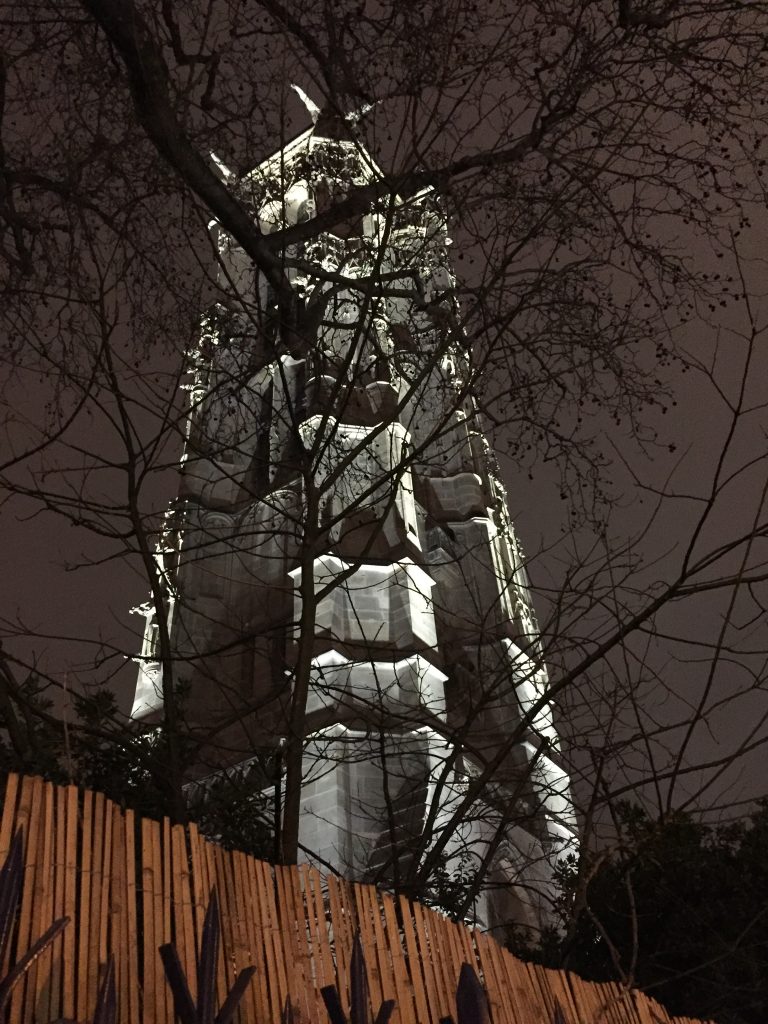
Hitler thought Paris was too beautiful to bomb
There are 40,000 public monuments
70% of bread is made by hand compared to 3% in England
On average there’s a bread shop every 100 metres
Lack of bread was a major cause of the French Revolution
The street and gutters are cleaned by swilling them out each morning at the touch of a switch
There’s a graffiti eradication squad for racial and sexist messages
Paris is the richest city in Europe
The indoor shopping passages which we’d admired were built to allow rich people to shop during the rain
Most office workers are given luncheon vouchers to make sure they eat properly
Paris has the highest proportion of singles in Europe.

DAY 5

This crab was alive 

Disgusting?!
Anna’s friend Cez was arriving tomorrow evening so I had booked myself an Airbnb close to the hotel. Its owner Gaeille came and brought me the keys to the place at 10 and as we followed her out it was already raining. We were to take the Metro to visit the Bastille Market.

Bastille market 
Anemones 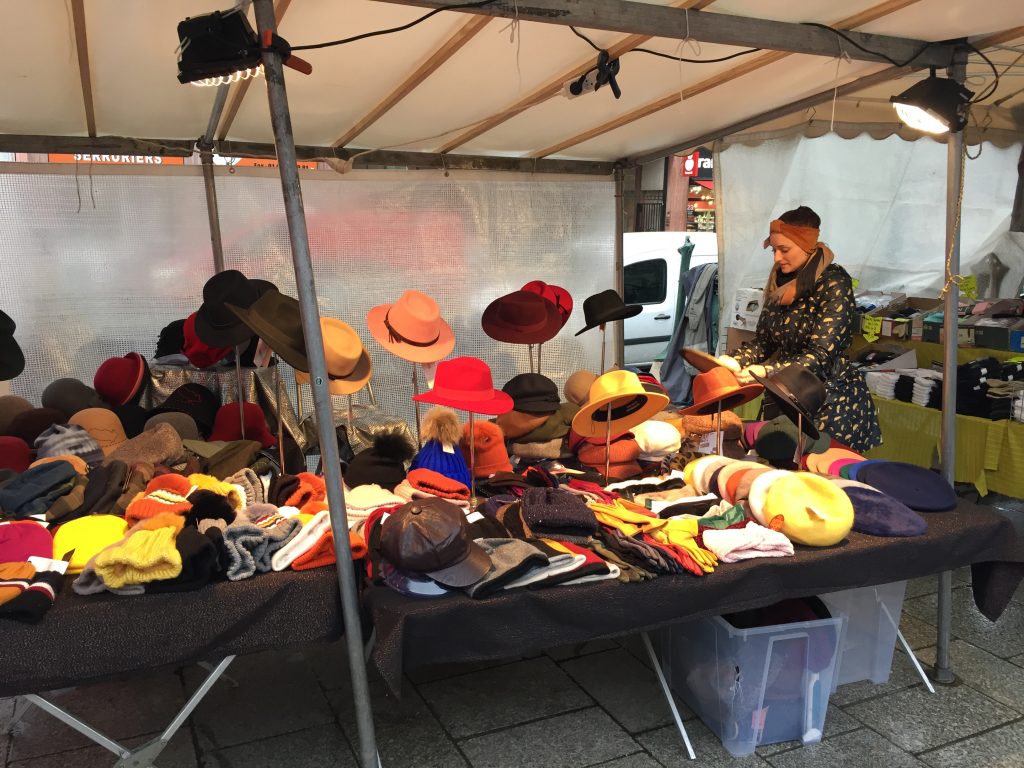
Which hat?
The cleanliness of the Metro stations is beyond belief. The white tiled walls are glossy and look as if they were built yesterday. We speculated as to whether they hose down each station during the night. The floor of the stations show no dust, dirt, spills, gum or anything else. The most rubbish I saw on a station platform was one ring pull from a can – in a whole week of using the Metro. The route indicators within the trains light up so so know exactly where you are in your journey. I was greatly amused that I read the station ‘Edgar Quinet’ as ‘Elgar Quintet.’ (!).
The outdoor market was vast but on this rainy morning customers were pretty scarce. Within minutes my feet were soaking wet, which was strange, since my shoes didn’t let in the water on our rainy walk last night. Anyway this prompted me to buy two pairs of socks for Euros each. It wasn’t until later that I realized one was Angora and one was Cashmere, both retaining their original price labels of 20 Euros. We chatted to a stall holder selling a new line in umbrellas, which can turn inside out. They come with lovely scarves to match. Other scarves featured hand embroidery using toro technique that I a recently learned in my textile class at home. During out morning coffee stop I donned my new socks and my feet dried out perfectly.

In the Catacombs
The afternoon was spent at the Catacombs which necessitated changing Metro trains at Chatelet which turned out to be an enormous station more like an airport. And SO many people. Directly across the street from where we exited the metro was a regular building which was the entrance to this vast underground system of tunnels filled with skeletons. You would never have suspected it. “Stop. This is death’s empire.’ Thus begins the path that leads through the remains of several million Parisians. The first bones were thrown here haphazardly into an abandoned quarry shaft.
The first bones came from the largest cemetery in the city at the time located in Les Halles district. The cemetery was closed in 1780 amidst concerns for public safety and little.by little the remains of people from various city cemeteries were deposited in the old quarries. There are signs in the passageways indicating which cemeteries the bones came from. Around 1810 the inspector general of the quarries decided to develop the area and the long bones and skulls were arranged decoratively to form a back wall behind which the other bones are piled.

These bone walls are called agues and there are corridors of them. Pillars of rock, left by the quarry men to support the ceilings are hidden by skulls and tibias. One of these in particular had became quite famous as the ‘tibia rotunda.’ One of these supporting pillars is surrounded by bones in the form of a barrel shape. On 2 April 1897 a night concert was organized there between midnight and 2 a.m.

The information was circulated in the newspaper and the concert drew over 100 people to hear Chopin’s Funeral March and Danse Macabre by Saint-Saens among other piece. There are hate remains of about 6 million people in these corridors and the bones of Charles Peroult who created Little Red Riding Hood and Cinderella are somewhere in this labyrinth. We visited the souvenir shop with its macabre trinkets before heading up onto street level. Anna bought a book about cats. She asked the lady at the checkout if this book was here because of the word ‘cat’acombs? No, it turns out it’s because Paris was known at one time to have a lot of cats, especially in the Montmartre district – hence Le Chat Noir, supposedly the first modern cabaret but now simply a hotel. Famous patrons included Debussy, Satie, Toulouse Lautrec and Verlaine.

Lunch was next and we stopped in a cafe where the service was very slow, even for European standards. A party of student aged people to our right were from Michigan and the couple to our left were from Redwood City. The group from Michigan complained to the waitress about the slow service – typical Americans!
We were bound for the canal district with its wrought iron bridges. There was a playground that was teaming with children and their carers. This was truly a multicultural district of Paris. The area reminded me of Amsterdam with bikes leaning on bridges.

The canal district 
Later, at dinner in an outdoor bistro I discovered a new beer Eidelweiss, which I enjoyed with my pizza while Anna tucked into a 1664 with her pasta. We walked down to the Seine after dark and watched the flashing lights of the Eiffel Tower.


DAY 4

A day filled with blue sky and we were on our way to find the Hop On/ Hop Off bus before 10:30. We saw from the website that there was a stop at the Opera House but having walked to this wonderful building but we couldn’t find a bus stop with our bus’s logo. Many streets converge at The Opera House and we were stuck. At that moment, while admiring the imposing facade of this famous music building with its larger than life sculptures of composers I glimpsed a security guard in the foyer.

So, we went into the Paris Opera house to inquire about a bus stop! That takes some beating. The subterranean “lake” below the Paris opera house inspired the Phantom of the Opera’s lair. Beneath the opera house, Palais Garnier, there sits a water tank, and some folk say that once a man lived there who had no face. “The Phantom of the Opera” was based upon this place. We didn’t see the phantom but we did get the information we needed from the security guard and we boarded our bus. We were paying the driver by credit card but his credit card machine wasn’t responding. Daunted not in the least, he pulled out into the crazy, heavy traffic and continued to simultaneously drive and fiddle about with the machine while we stood by the driver’s seat hanging onto the rails for dear life – quite unnerving. Eventually he gave up and told us to take a seat and he’d pick up a new machine at a stop later in our ride. We headed upstairs and in spite of being a little disappointed that this bus still had its awning in place , so it wasn’t quite ‘open top,’ we got great views of Notre Dame under cover, all wrapped up after last year’s devastating fire, with mighty cranes looming overhead.

Notre dame 
Scaffolding covered some walls and it did give a sense of what it must have looked like during its original construction. The flying buttresses are supported by wooden frames and all the cranes were active. We decided to get off the bus and have a closer look and we browsed the outdoor photo exhibition of the fire.

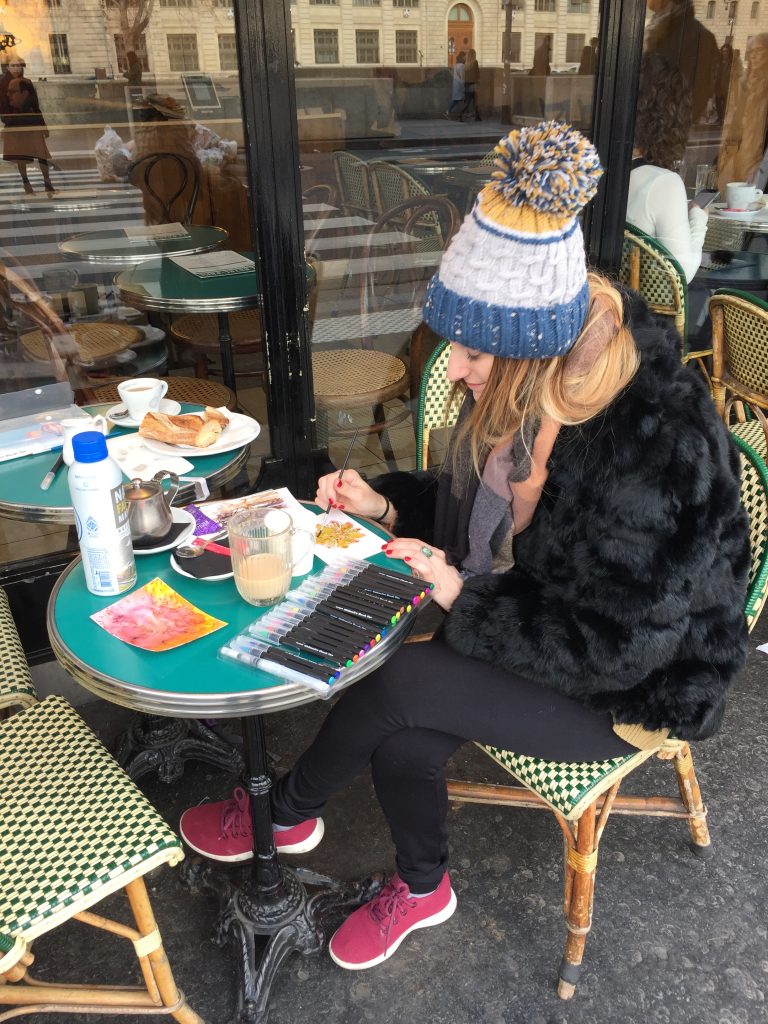

We stopped at an outdoor bistro directly across from the cathedral and had the most expensive cappuccinos of the trip – 6 Euros – but that’s rather cheaper than in St Mark’s square in Venice.

We took out our watercolors and painted for an hour – what a view of the cathedral we had from our table! Several times police sirens broke the quiet as a dozen or so police vans filled with policemen in what looked like full combat gear whizzed past at high speed. When we came to re-board the bus the whole bus lane was taken up by a parked convoy of police vans.
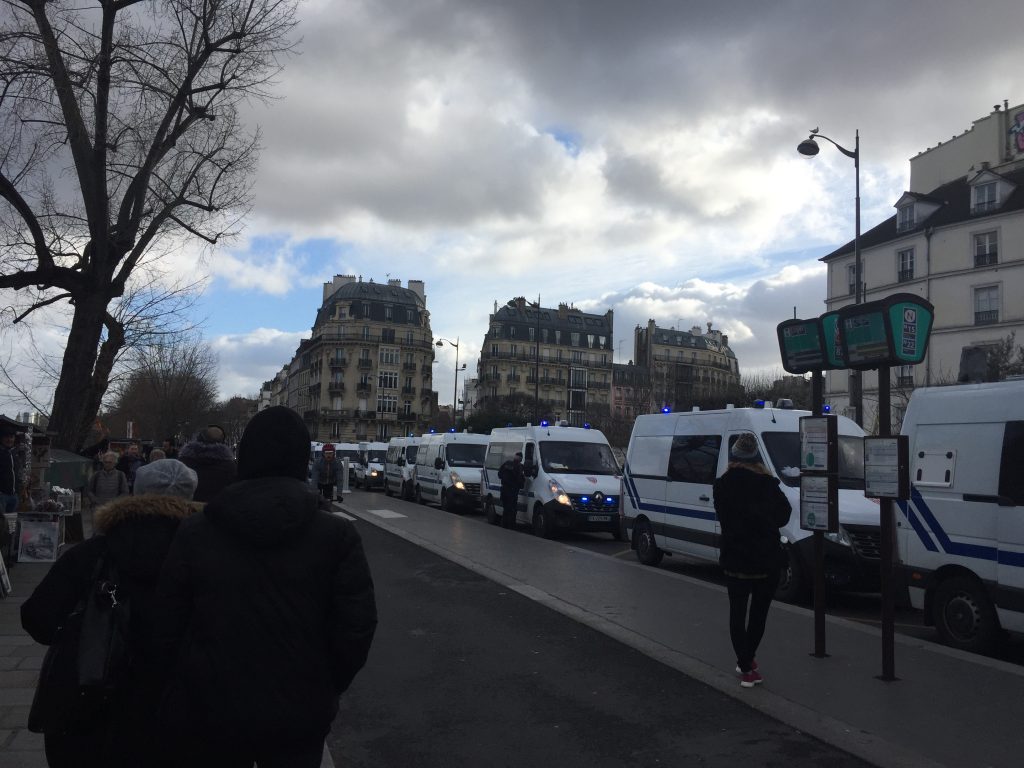
Several tourist stalls were set up along the river bank and Anna bought a new bobble hat.
Our next stop was the Eiffel Tower, constructed in 1889, and we approached it through a park with rows of strangely pollarded trees.

We weren’t going to go up the tower but the line to go up didn’t look too long. Up this close the engineering feat just blew my mind – how could anyone could design something that had so many separate pieces all riveted together? Apparently there are 2.5 million rivets. (Thanks to Griff again for that piece of trivia.) It’s also the world’s most visited tourist attraction. We walked towards the steps at the end of the boulevard. Anna wanted to get her profile photo taken there a while ago updated.

We were now deep inside tourist territory with people glued to their phones posting their photos to social media , admiring the street artists and browsing the souvenir stands. However, in all this I simply could not find a bathroom. We wandered around for what seemed like an hour, someone eventually directing us to a street toilet, but the door wouldn’t open. Finally I entered the Museum of Man (!) and used their facilities. As we came out I took a photo of some gold colored statues on the side of the square. It wasn’t until I arrived home that I found that my dad had taken a photo from exactly the same spot. When I was quite young, maybe about 8 years old he had organized 2 trips to Paris for his high school art class in the Easter holidays.

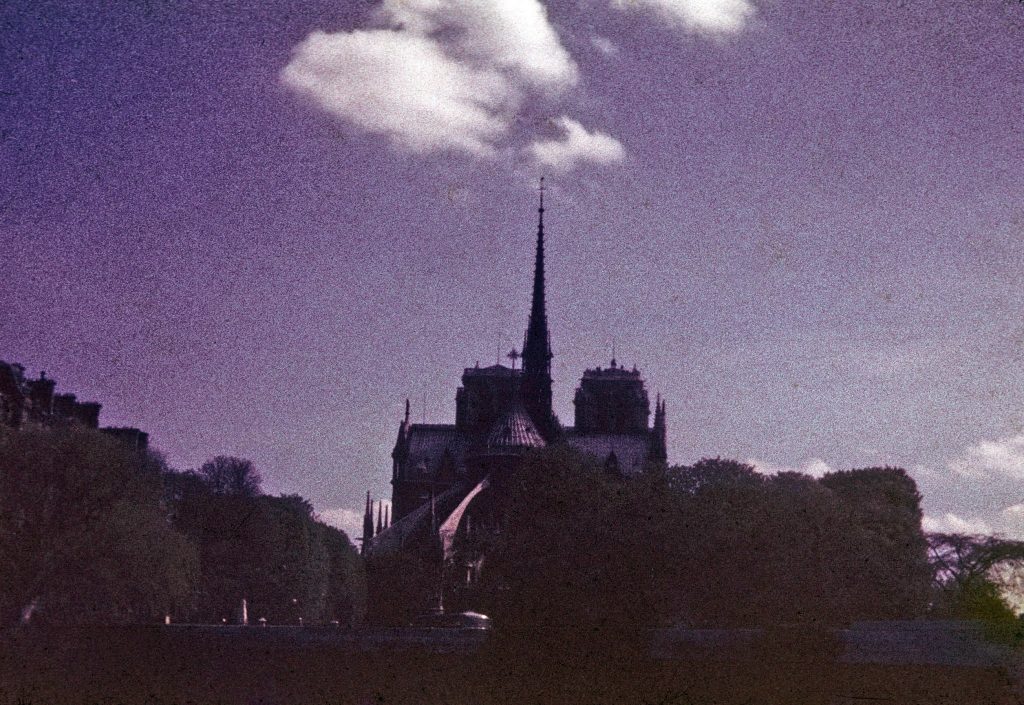
My dad’s slides of Notre Dame 
He took a few slides that have deteriorated badly but I had them digitized a few years ago and so now, with this trip, I was able to identify the exact places that several of them were taken from. It wasn’t until that moment that I connected these trips taken in the early 1960’s with Anna’s love of Paris, the only place ‘abroad’ that my dad ever visited.
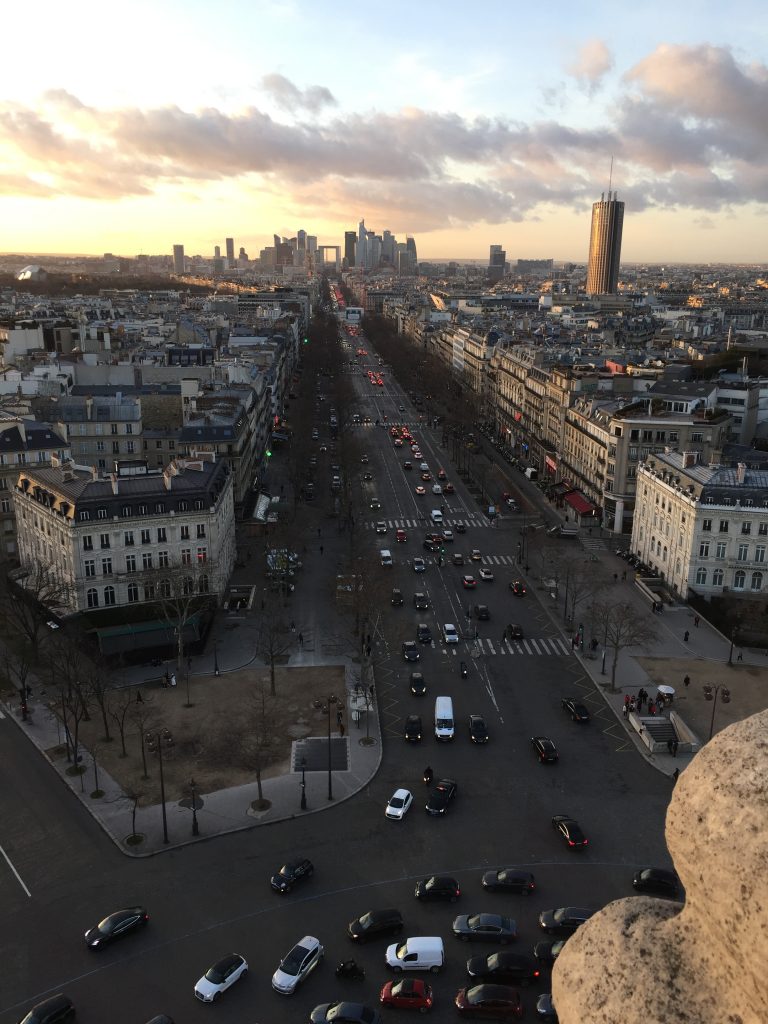
View from the Arc de Triomphe 
We watched the sunset from the top
Back to the bus and our next stop was the Arc de Triomphe. Known as ‘the greatest obstacle to road safety in Paris’ twelve major roadways converge at this famous landmark. There are no road markings of any kind and we were relieved to find a subway. When someone at choir the following week asked me about my trip she related the story of how her and husband had walked across!! When I’d gone to Paris in 1984 I’d stayed at the bottom of the monument while Colin had gone up to the lookout point so this time I was eager to get to the top.

A staircase leads to the top but several displays about the building on various levels break up the climb. We had timed it just right and we were able to watch the sun set, along with many others vying for the best position to take their photos. After the battle of Austerlitz Napoleon promised his victorious troops that they would enter Paris through a triumphal arch. However, it wasn’t completed until 50 years after his death. Beneath the arch is the tomb of the unknown soldier which is relit in a military ceremony every evening at 6:30 and we watched the uniformed men preparing, though we didn’t stop to see the event because, with the setting sun, it had suddenly got much colder.

We ran to catch the bus back to our hotel, Anna fortunately retrieving her new bobble hat that she’d left on the bus. After freshening up for half an hour we were back out, this time heading for a bar to watch Manchester United v Manchester City in the Carabao Cup. We’d inquired earlier if this bar would be showing the game and the barmaid had even checked to see if it would. When we walked in she recognized us and immediately turned the two screens onto the correct channel.

During the game we were able to observe locals at play. It was strange to us how all the men gathering in groups kissed each other as a regular form of greeting. There were several groups of men, chatting, checking their phones, but there were also many tables with a couple of guys enjoying an evening together. This felt quite different from both England and the U. S. There were no loud cheers or moans during the game and it was obviously that only a few people were watching it. The backdrop to all this activity was loud music, very loud hip hop with some African style too. It was a good job we hadn’t come in for a quiet chat! Nemanja Matic put United ahead with their first effort at goal though he was later sent off but it’s City who will go through to the next round at the beginning of March. As the match came to a close a few people got up to dance and the curtains onto the street were closed. The bar had turned into a club which would be open til 2 a.m.


DAY 3
We were out of the hotel before 10 after a breakfast of yogurt for me and protein powder for Anna. We passed a small embroidery shop where I couldn’t resist buying a few items for future projects.

We were bound for Pere Lachaise cemetery and we were going on the Metro. Anna negotiated the ticket machine. You can travel anywhere on the Metro for 1.80 Euros. No wonder every train is packed – it’s so cheap. Not only is every train packed but we never had to wait more than 3 minutes for a train during the entire week. We travelled 9 stops and exited a spotless station into the bright sunlight and found ourselves right at the entrance to Paris’s most famous resting place. We took a photo of the large map on the entrance gate but when we tried to locate the graves we wanted to see we had little success. With more than 3.5 million visitors annually, it is the most visited necropolis in the world but we passed many other tourists staring confusedly at their phones trying locate tombs they were hoping to visit but there were no docents around or signs to specific graves.

Don’t lose your head 
Interesting . . . 
Grave of Oscar Wilde
The grave sites at Père Lachaise range from a simple, unadorned headstone to towering monuments and even elaborate mini chapels dedicated to the memory of a well-known person or family. Many of the tombs are about the size and shape of a telephone booth with just enough space for a mourner to step inside, kneel to say a prayer, and leave some flowers.
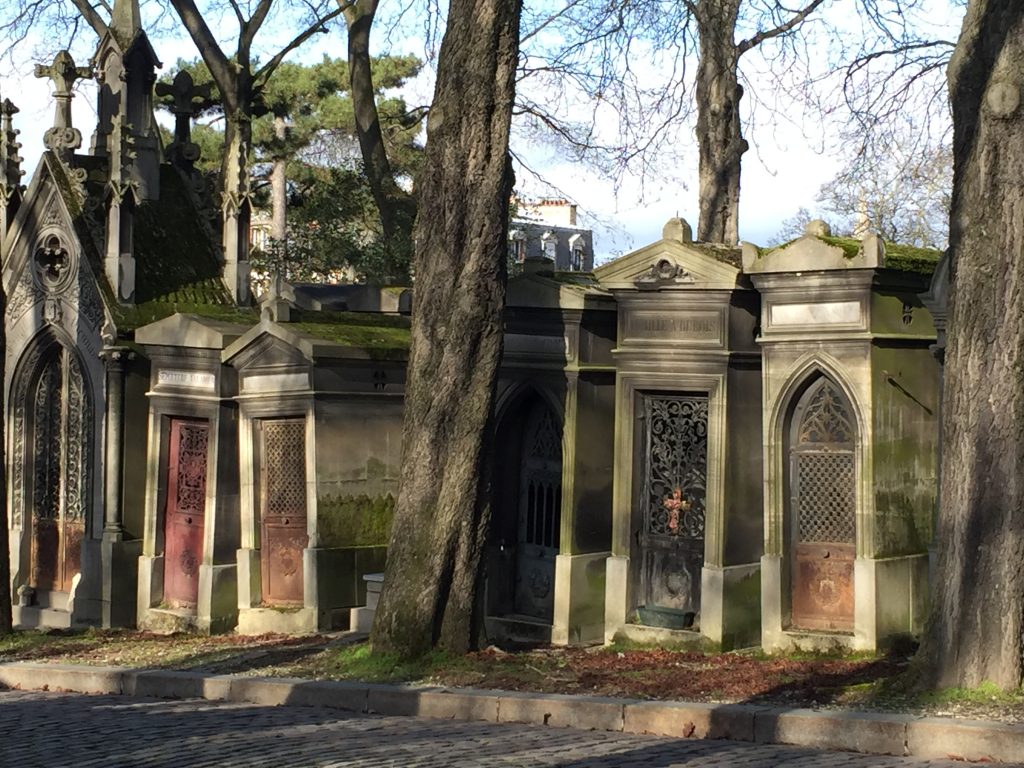
Nobody can say for certain how many people are buried here, but estimates vary from 300,000 to 1,000,000. We knew that some of the most visited graves are those belonging Jim Morrison and Oscar Wilde. Eventually we found Oscar Wilde’s – a rather odd sculpture. The tomb, designed by Jacob Epstein in 1914, features the sculpture ‘Modernist Angel’, which is roughly three meters tall and very impressive. It is surrounded by glass and a sign reads Don’t deface the glass because the Wilde family are responsible for the clean-up. Many Metro tickets had been thrown into the glass enclosure, along with a few letters. Apparently the tomb gets around a thousand visitors per day but there were only a couple of people there besides us. Even Jim Morrison’s grave was hard to find.

It’s tucked in behind others and covered with many flowers, and a bamboo screen covered in chewing gum (!) .

Soon after Morrison died (in Paris, of a suspected drug overdose), his body was placed in an unmarked grave in the cemetery. When the decision was made to mark the grave with a simple sign it was promptly stolen. After the same thing happened to a bust of the musician, a guard was installed to ensure that visitors did not deface or destroy the grave in any way. The final resting place of Chopin and Edith Piaf were on my list but we’d just about given up trying to find them when we were approached by a gentleman, dressed in black, who introduced himself as Rafael.

Grave of Cherubini 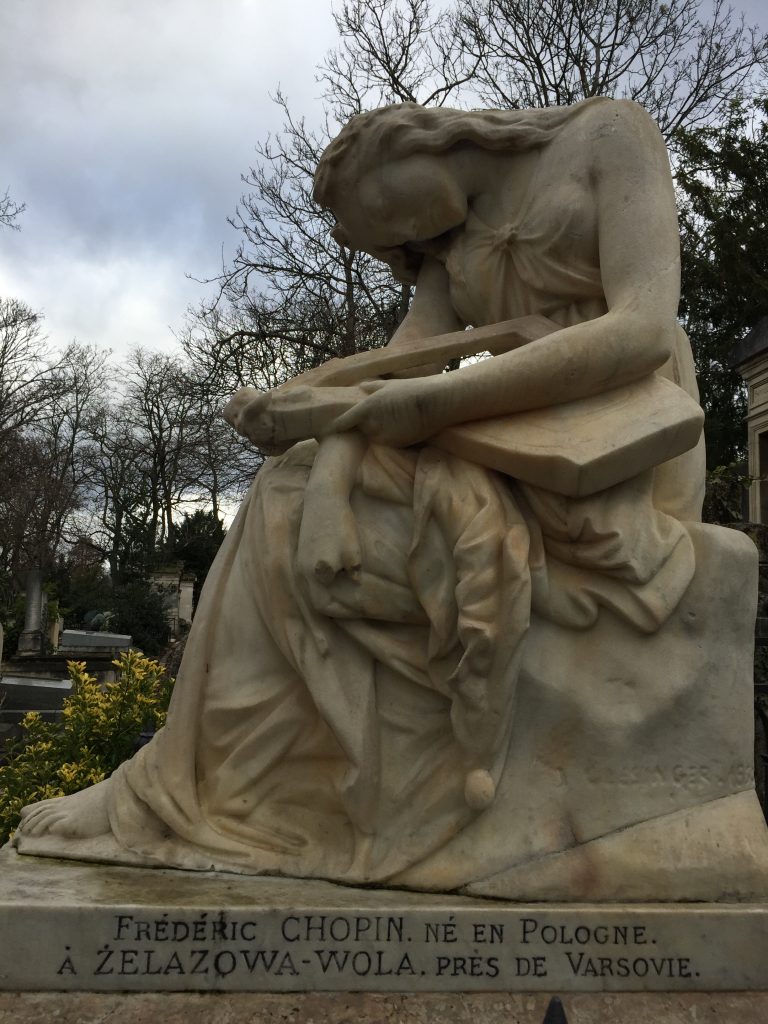
Grave of Chopin
“You are looking for the grave of Chopin? I will take you there. Short cut!” And with that he set off at a gallop between graves, along slippery slopes, checking to see if we were following him and keeping up a running commentary about all the musicians associated with the cemetery and Paris in general.
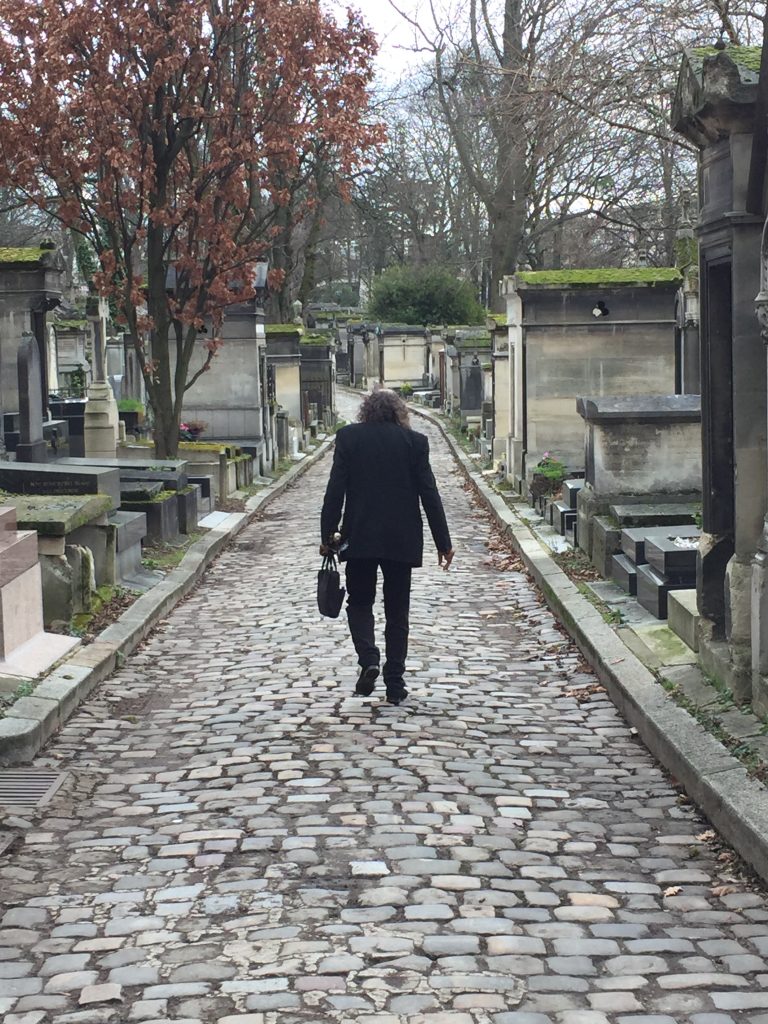
He seemed impressed by my knowledge but I was more impressed by his! Anna signalled to me her unease and indicated that Rafael would demand money from us, but, having just been about to give up in our search I was happy to hand over a few Euros. As I clung to iron railings surrounding graves to avoid slipping he reeled off the names of all the composers buried here. “Poulenc, Bellini, Pleyel, Erard, Cherubini, Bizet, Dukas, Enescu,” He even led me to a grave on top of which was a sculpture of a small piano, and insisted I pose for a photo. Feeling very fortunate to have been given our own personal guide we took our leave – and he didn’t complain too much about his tip!
Before leaving the district we had lunch at the Bistro du Metro – coffees, crepes and fries. Just why are they called French? There are many explanations, but all I can say is that all the French fries we had on our trip were delicious. I brought out the watercolour pens that had been a Christmas present from Anna and we played with those for a while.

After lunch we were off to see Park des Buttes, a little oasis in the 19th arrondissement. The park took its name from the bleak hill which occupied the site and , had a sinister reputation; it was the site of a gibbet, the notorious place where from the 13th century until 1760, the bodies of hanged criminals were displayed after their executions. After the 1789 Revolution, it became a refuse dump, and then a place for cutting up horse carcasses and a depository for sewage. The director of public works of Paris and builder of the Park, Jean-Charles Alphand, reported that “the site spread infectious emanations not only to the neighboring areas, but, following the direction of the wind, over the entire city. ” In 1864 work began on turning the site into a park and the designer was Alphand who had designed the Bois de Boulogne. A waterfall, a grotto and lakes are spread out over 60 acres at the centre of which is a lake with a rocky island with steep cliffs made from the remains of a gypsum quarry. There’s also a miniature Roman temple that we were able to hike up to for a great view of the park and its display of winter pansies.
We headed back to the hotel for an hour’s r and r – a nap for me and a workout in the hotel’s gym for Anna and then we set off for our evening’s adventures.
But as we exited the hotel we discovered that it was raining – heavily. I hadn’t brought my raincoat with me that evening and so I ended up getting my down jacket soaked though, all the way to the inner lining. Not a smart thing to do. I suggested that we took the funicula up to the top of Montmatre, since I’d missed that experience by walking up on my first morning, and though the windows of the cab were streaked with rain we had a glorious view of the floodlit church.

We were heading for dinner at Deux Moulins, a restaurant where the movie Amelie was filmed. This entailed quite a walk through Montmatre with the city lights reflected in the puddles and spray kicked up by passing cars and bicycles.

The restaurant wasn’t overly fancy but my dinner of salmon (cooked, this time) with mango, papaya and rice was delicious. Pictures from the movie were framed on the walls and in a display cabinet sat several gnomes. In a window seat was a man eating alone. Across the table from him, watching his every move was an enormous fuzzy teddy bear.
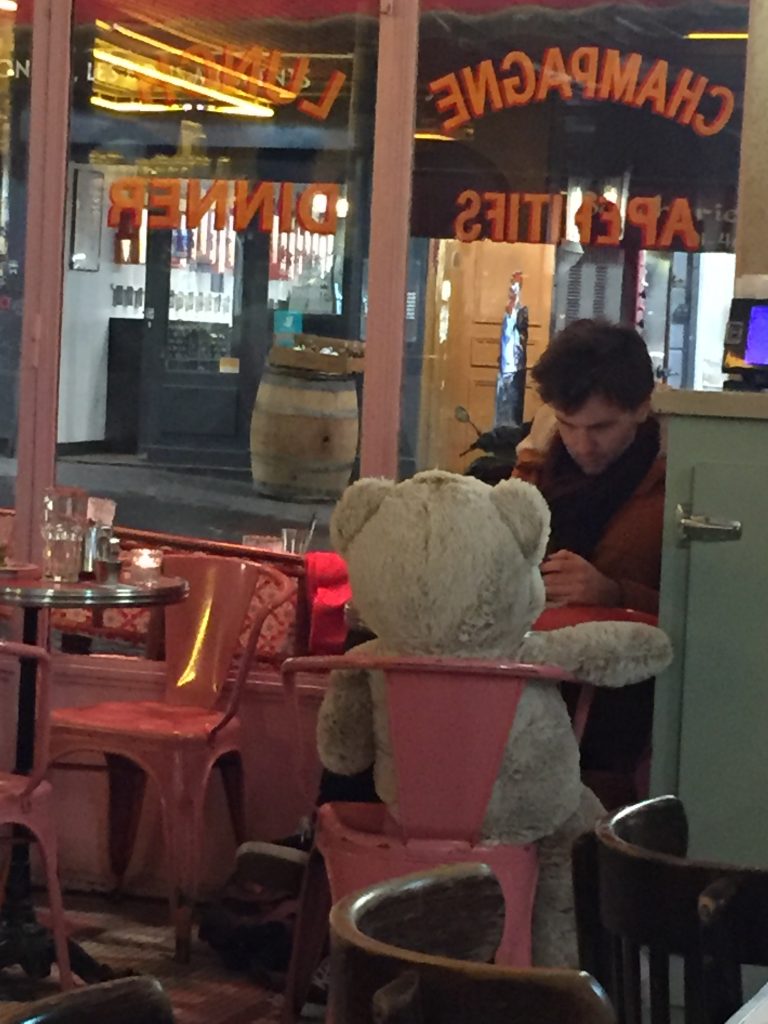
Close to the bar was a piano with the sheet music of the theme tune to the Amelie movie sitting on top. When the waiter came to take our order I pointed to the piano. “You must!’ he replied. He reminded me very much of the stand up comedian I had seen last week in Hebden Bridge, Marcel Lucont (https://marcellucont.com/), flirtatious, expressive, with a winning French accent. After we’d eaten I went over to the piano. The piped music came to a stop and I started to play. It wasn’t until I came to turn over that I discovered that there was no second page. I erupted in laughter as the entire restaurant applauded. That was fun. https://www.youtube.com/watch?v=CiR44lrl4BE&feature=youtu.be
Soon we were on our way to Le Lapin Agile. I’d made reservations online at this cabaret where Debussy and Satie met. Picasso and Modigliani were regular attendees. It’s just a small building like a house. It existed in 1860 under the name Au rendez-vous des voleurs, and twenty years later the walls were decorated with portraits of famous murderers and the place became known as the Cabaret des Assassins.
Tradition relates that the cabaret received this name because a band of gangsters broke in and killed the owner’s son in a robbery attempt. In 1875, the artist Andre Gill painted the sign that was to suggest its permanent name. It was a picture of a rabbit jumping out of a saucepan, and residents began calling their neighbourhood night-club Le Lapin à Gill, meaning “Gill’s rabbit.” Over time, the name had evolved into “Cabaret Au Lapin Agile,” or the Nimble Rabbit Cabaret. The original painting on canvas was stolen in 1893 and a reproduction on timber was painted to take its place. It was very dark inside with minimal lighting. We hadn’t paid online and my name was handwritten on a tiny scrap of paper at the desk. Our coats were taken and we were led to a table in a small darkly lit room where a man was playing the piano. And what a pianist he was. Although the piano was a simple Yamaha the sound quality he got, from the upper notes especially, was amazing.
About 15 people were sat at wooden tables deeply scored with the names of previous visitors, listening to this pianist. The two girls next to us were visiting from Belarus. The walls were filled with paintings and sculptures so that there wasn’t an inch of space remaining. About 20 minutes later 6 people entered and sat at a table together and we presumed they were just more visitors. But then they began to sing along to some of the songs from the piano man and we realized that this WAS the cabaret. The ‘real’ guests joined in with the singing of many of the songs, and one by one the artists sang solos and did turns on the piano. Judging by the reaction of the visitors many of the songs were hilariously funny but, of course, they were all in French, so we just watched, which was almost as much fun. https://youtu.be/tjtTqByI-gw
One singer accompanied herself on the piano but stood with her back to the keyboard and played it behind her back. It was almost midnight when we left this wonderfully evocative place that had been the starting point for so much music and art. We took a taxi back to the hotel where my sodden coat dried out overnight perfectly in the heated bathroom.

Day 2

(Sitting in a cafe overlooking the street where I should see Anna pass as she leaves the station and heads for our hotel. Opposite my sitting spot is Cafe Marmite on the Rue de Paradis!)

This morning I set off for 6 Rue Cortot, the one time home of Erik Satie. Once I get used to being alone in a city I really enjoy the freedom to do as I please. Satie hd lived close to the Sacre Coeur and I decided to take the back route which would enable me to take photos of the ‘alternative ‘ Paris, not the regular tourist photo stops. And I sure got what I was looking for on the steep staircase up the hill. Sandwiched between 4 and 5 stormy apartments the sides of the buildings are covered in graffiti.

It wasn’t easy to take photos here: the steepness of the stairs being the least of my problems, but the stairs were crowded by large groups of tourists, mainly Japanese, all wielding umbrellas in the gentle rain. What with trying to avoid having my eyes poked out by the umbrellas and not tripping over feet it was quite an experience in keeping safe, let alone stopping to take photos of the artwork.
At the top of the stairs I found myself in an open square lined with tourist trucks preparing for the day but right now business was fairly quiet. I made a note to myself to come back at a busier time.

I was at the back of the Sacre Coeur and Satie’s modest apartment was less than a minute’s walk from the church. Only a small plaque on the wall indicates his home, but appropriately enough a bicycle was leaning again the wall, something I think Satie would have liked. His apartment used to be a minuscule 9 m2closet, mysteriously big enough to fit his collection of 100 umbrellas, 2 pianos placed on top of each other and 12 identical corduroy suits, accounting for his pseudonym “the velvet gentleman”.I recalled that several years ago one of my adult students showing up for a recital to play some Satie music dressed as Satie. What a hoot! Satie wrote: Here is a time-table of my daily acts. I rise at 7.18; am inspired from 10.23 to 11.47. I lunch at 12.11 and leave the table at 12.14. A healthy ride on horseback round my domain follows from 1.19 pm to 2.53 pm. Another bout of inspiration from 3.12 to 4.7 pm. From 5 to 6.47 pm – various occupations (fencing, reflection, immobility, visits, contemplation, dexterity, natation, etc.)”

Satie’s house 
I joined the tourists and entered the church. A service was in progress but the 50 or so members of the congregation were significantly outnumbered by the tourists, who were, for the most part, observing the ‘Silence’ notices. I took several photos of simple floral mosaics thinking that they might be the inspiration of a future needlework project but I found that I didn’t feel any sense of awe or wonder inside the church. It didn’t have that feeling of an ancient building, a place of meeting for hundreds of years that I feel with many churches. And it wasn’t until I did some more research that I discovered that it wasn’t built until 1898. So when Satie had lived close by the building would have been under construction.
Exiting the building I came out onto the terrace with its wonderful view of the whole of Pairs, for this is the only hill, the only piece of raised ground in the city of Paris.

The fence on the terrace is completely covered in locks and street vendors were selling more locks and various trinkets on the steps. I headed down the steps taking the normal tourist photos, checked on Anna’s flight, which was over an hour late departing from San Francisco and suddenly, before me was a view that I recognized! Before my trip I’d been looking at photos of my only previous trip to Paris, 37 years ago (!!!), and had seen a photo of me looking at the map outside a Paris Metro station. And now, here it was right in front of me, in all its Art Deco glory. I found the picture on my phone, posed myself in the identical position. Even the tree across the street was still there. Being cautious in this tourist spot I selected someone to hand my phone over to, showed them the original photo, and asked her to take the same shot – ’37 years have gone behind.’ What fun.
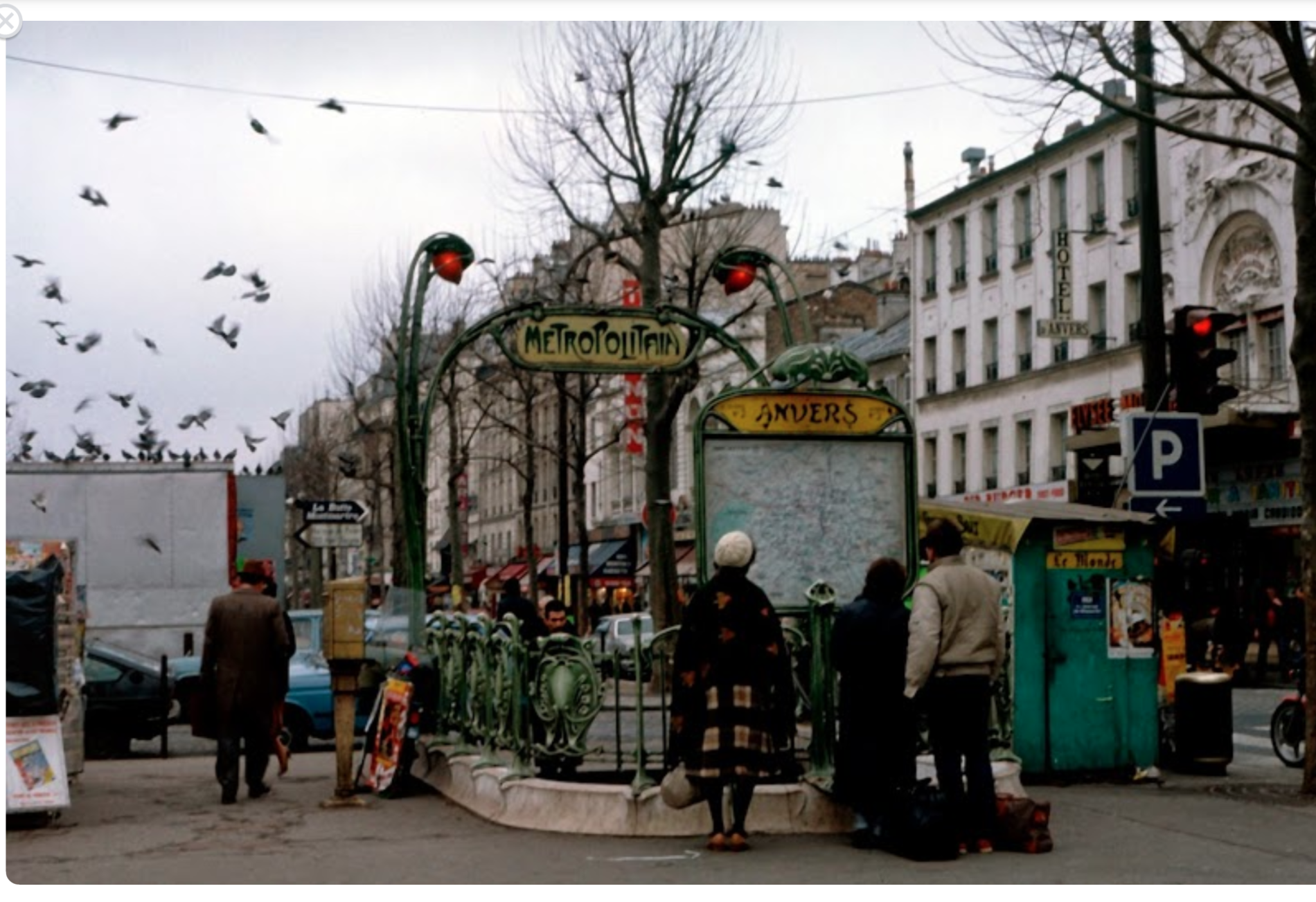
Me, 1984

Now it was time to head back to the hotel and wait for Anna – but, hmmm, it might be fun to see her arrive! I found a cafe on the Rue du Faubourg Poissonniere, took a table overlong the street, ordered coffee, (noted that I was only woman in the cafe – again) and wrote up my journal. 20 minutes later I looked up to see Anna across the road walking at speed towards the hotel, looking very determined, in fur coat, dragging her roly bag behind her. Oh dam! I haven’t paid for my coffee yet. I urge through the sea of men propping top the bar, pay, and head out onto the street. Already she’s way ahead of me and I break into a run to catch up with her, but to no avail. I arrive at the hotel door in time to see her enter and speak to the concierge. I fling my arms round her, surprising her – much to the amusement of the friendly concierge – and we head up to our room on the 4th floor.

She’s just flown across the entire width of America and the Atlantic Ocean, her 10 hour flight but doubt morphing into at least double that in total journey time but after a quick shower we head out for lunch. Anna’s got her heart set on a baguette and we find a lovely little cafe providing a baguette, a quick and a doughnut. (Crazy fact I later learned from a Griff Rhys Jones documentary about Paris: baguettes aren’t a Parisienne invention – they come from Vienna!)
We wander round the streets admiring the tiny shops, with soft, enticing lighting. Some of the shops are smaller than my living room. The window displays are lovely. So, so very different from America’s ‘the bigger the better’ philosophy. The cafe bars with their colorful awnings supporting heat lamps are filled with people, chatting, laughing. The entire vibe is so different from Oakland – and Hebden Bridge. Everything looks inviting. We wander down to the Seine and as we cross the Pont du Neuf we see a flashing sign on a moored boat – Next Departure at 3:30. That’s in 2 minutes! We set off at a gallop and rush to the ticket desk. “Is there still time to board the 3:30 boat?” We gasp. “Yes,” and we board. It’s cold and rainy so we have to stay indoors and during our hour’s cruise Anna had a hard time keeping awake, not surprising. Out ‘guide’ cracks us up. She describes what we are seeing in French and then retells it in English b but her ‘English’ is voiced with exactly the some inflections and intonations as the French version and we are actually unable to tell when she switches from one language to the other! Hilarious. We pass under many bridges. I idly wonder why there are so many iron rings attached to the underside of these bridge. Surely it can’t be to moor. We pass the golden domes of the Russian church and find ourselves close to the great feet, and great fete, of the Tower Eiffel. Elegant statues adorn the bridges, and many of them have carved stone faces set into the stonework. We pass close to Notre Dame, now clad in cling wrap and dwarfed by the gigantic cranes.

We head back to the hotel so Anna can take a nap. She’s doing so well with the jet lag.There’s a 10 hour difference between Oakland and Paris. I stay awake and watch her sleep (it’s a mum thing) while busying myself with my last cross stitch panel of a hillside above Hebden Bridge. The colorful graffiti would make another interesting panel. I did one of those last year, of some street art in Manchester and enjoyed that project.
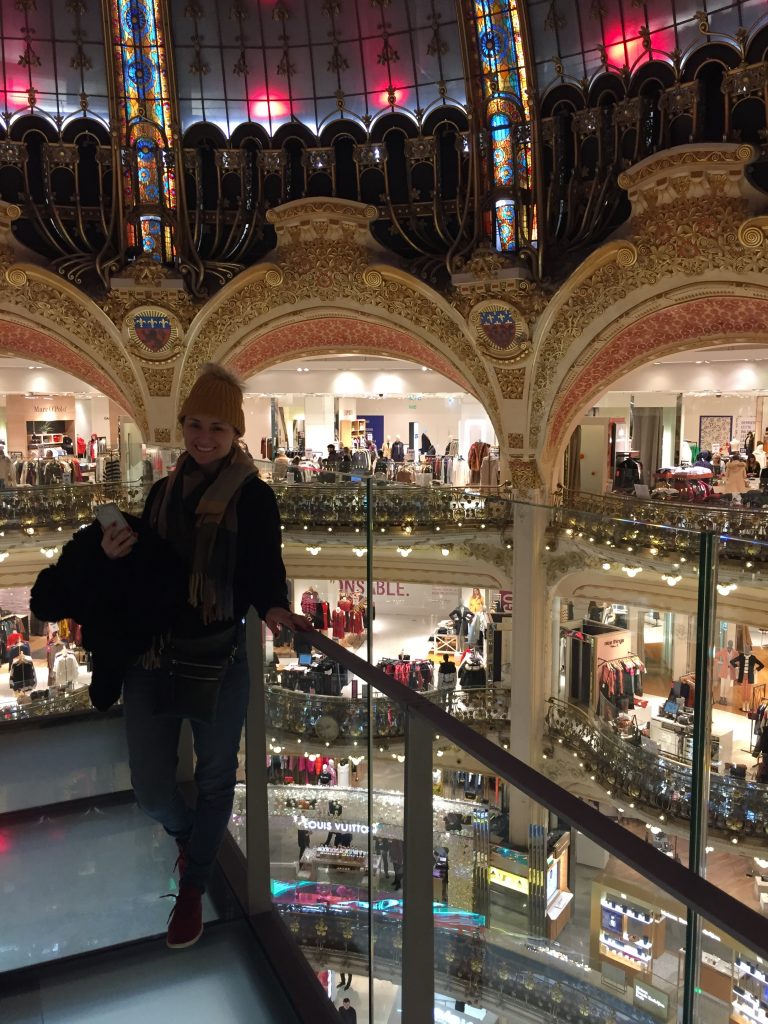
On the viewing platform 
The dome 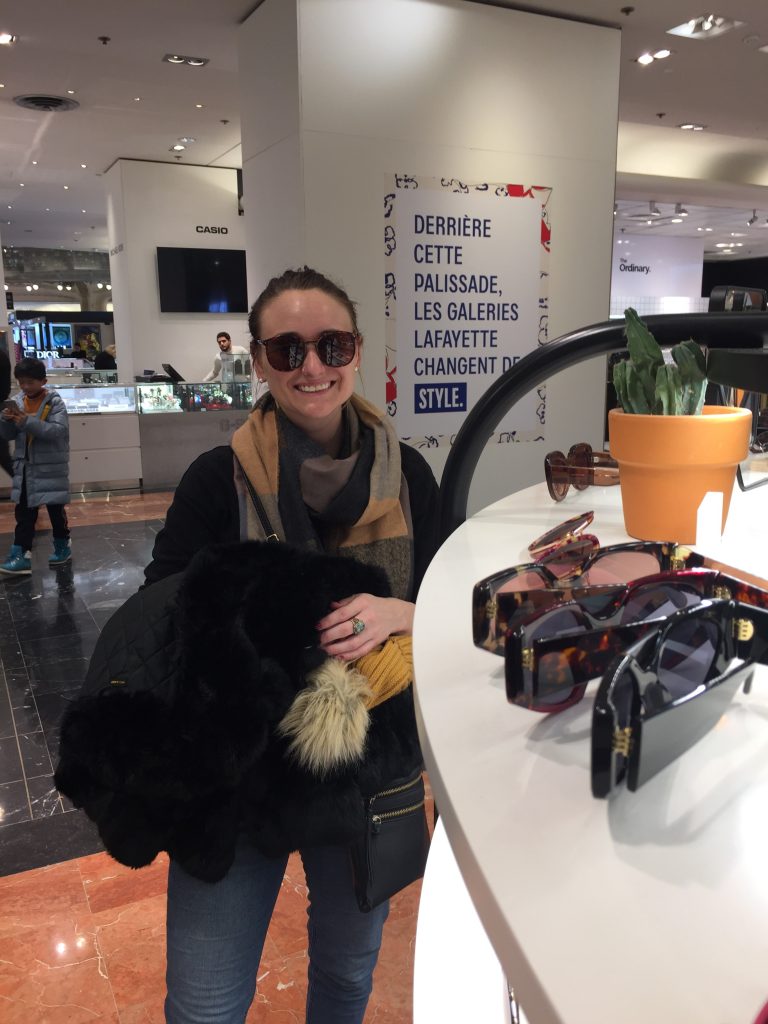
Should I buy these, Mum?
We were back out by 6:30 and remarked that it was definitely warmer, but wetter. We were heading for the Galleria La Fayette (sort of funny because we used to live in Lafayette, California). Out first attempt at following Google Maps to that location took us to their offices, but we were redirected to the building itself which can only be described as the Leeds Corn Exchange on Ecstacy. Top notch stores are housed in a beautiful building constructed of glass and steel and topped by a panoramic dome. It was built in 1912 and is Art Nouveau in style. Even just looking at the fashions I felt decidedly underdressed. Clad in my raincoat and woolly hat with my signature purple backpack I looked ready for a ‘hike on ’t tops’ – not an evening in Paris. There were lots of clothes that we actually liked, some tasteful souvenirs, and Anna was tempted to buy some sunglasses she tried on. We walked out onto the viewing platform since the dome was closed for the evening, but with a glass floor and a 7 story drop beneath me the most I could do was to take a quick photo of Anna without allowing myself to look down! We stayed in the shop until closing time at 8 and then went in search of dinner. I wanted a busy place with the buzz of the city and we found Comiere, a bar which filled the bill. My salmon salad was delicious, but, just as in Malta, I hadn’t expected the fish to be raw. We were back in the hotel by 10 after a very, very, long day for Anna.


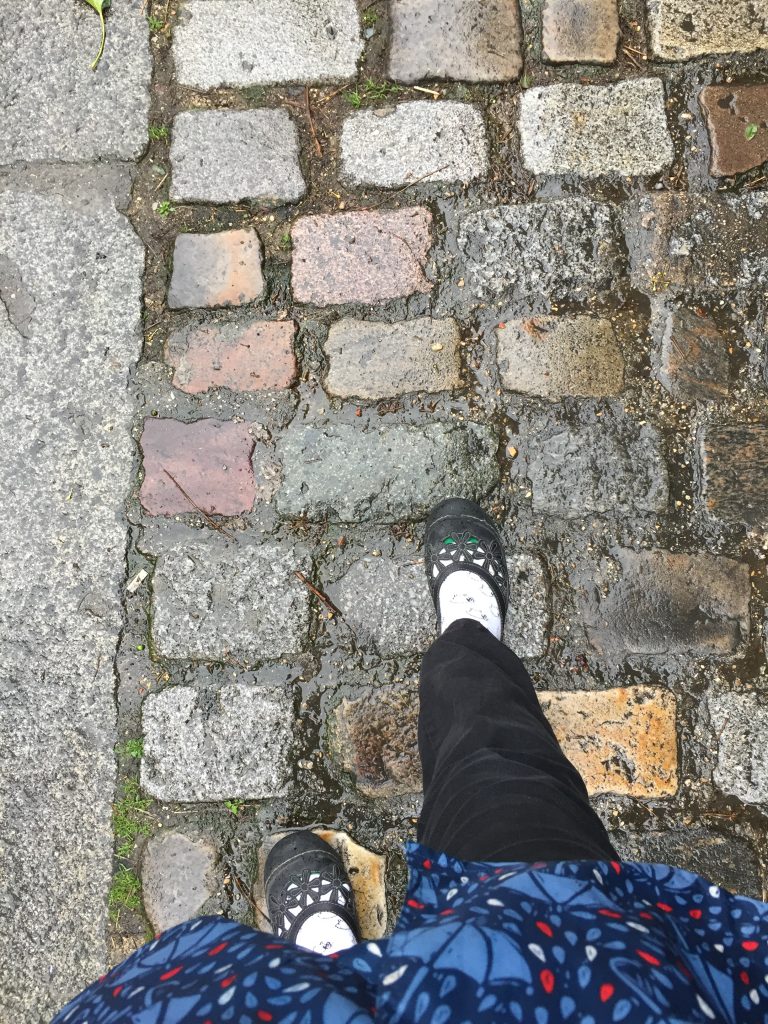
PARIS – January 26-February 2, 2020
Day 1

(Written in Cafe Richard. I’m the only woman. All the men are standing at the counter, some reading the daily newspaper, others – construction workers judging by their garb – gulping down quick espressos before heading back to work in the drizzling rain)
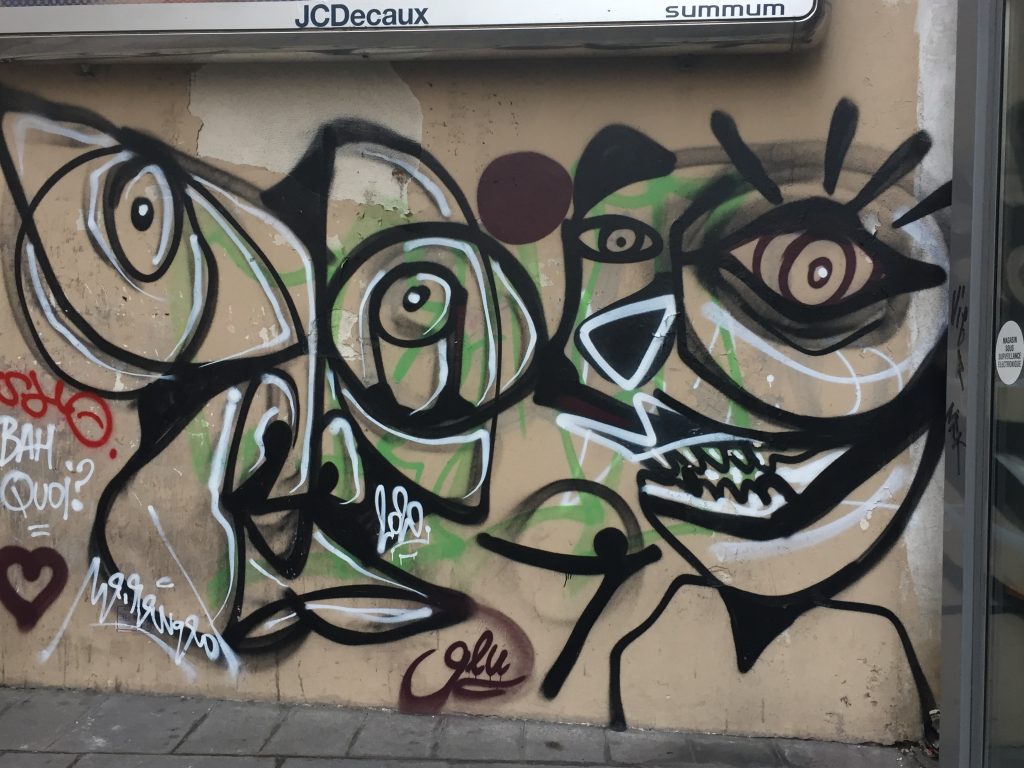
“I feel as if I’m in a jigsaw puzzle.” So began my journal of a week in Paris, January, 2020. Not long ago on Boxing Day Anna had messaged me “by the way, if I accept this new job I’m thinking about going to Paris for a little a while. Would you be interested in meeting me there or would you rather I come to Hebden Bridge?” And so the journey was planned. Anna’s been to Hebden Bridge a few times now, and has seen my new apartment so there was nothing new to see and do here, but at the same time I felt that if we just zoomed around the tourist sites of Paris I would miss out on having ‘time’ with her just to sit and chat and be together. On the other hand I’d really enjoyed our tip to Staithes together in the summer so we both started to make lists of things we’d like to do in the city. And I dug around and found some hilarious photos (from slides, of course) that Colin and I had taken in 1984, the only other time I’d ever been to Paris. Anna, on the other hand has already visited the French capital 3 times and had therefore ‘done’ many of the ‘must see’s. On my previous trip we’d both ended up with terrible food poisoning and I’d spent all my afternoon at Versailles throwing up in the toilets, the same at the top of the Eiffel Tower, and had ended up rushing out of a cafe bar in the Place Pigalle to throw up in the gutter – sorry, no reflection on the quality of Roxy Music soundtrack in the bar. Perhaps because of these associations I was apprehensive. But then, I’m always apprehensive before a trip of any kind. It’s almost to the point that the day before I want to call off the whole trip because I’m just too afraid. Too afraid of flying, of misplacing my travel documents, of finding my way to the hotel, locating the correct train at Charles de Gaulle airport, of having to spend a couple a days in the city by myself, eating out alone etc. You’ve got the idea.

There was as much graffiti art as in Sicily 
I took a taxi to Manchester airport. It was foggy all the way through the flight so I didn’t get any view at all. The train station wasn’t easy to find at the airport but once on the train I began to relax. The journey into central Paris was very much like the train from Frankfurt to Wurzburg that I had taken last August. But then, I reasoned, that’s not surprising because that was the last train journey I’d taken through Europe since goodness knows when . . . 1999?

TinTin and Captain Haddock. Apparently this is on the LGBT list of things to see in Paris. I took the photo because my daughters loved the TinTin stories
Last night I had dinner in an outdoor cafe – the only person dining alone. Despite the chilly evening the overheat heaters made sitting outside a pleasure. Obviously I’d managed to find Hotel Aida Opera. It was quite an easy walk to follow on my GoogleMap once I’d found the best exit from the huge Gare du Nord, with its multitude of police in full combat gear brandishing machine guns – just a regular security patrol but it startled me for the instant. I’d asked for assistance from the info desk and it was given. Excellent. Our room was on the 4th floor overlooking a street of 4 and 5 story apartments. I noticed immediately that it didn’t have a kettle. I asked the concierge if I could have one but no, no kettle. However, he did come back with a thermos flask and since there was boiling water in the lobby 24/7 I could drink my tea to my heart’s content.
I had a well-needed cup a tea, nibbled on some pretzels provided by the hotel and in less than an hour I set out to explore the neighbourhood. I just couldn’t believe how many people were out in the streets. I mean, this was 4:30 on a Sunday afternoon. The narrow streets, some no wider than passageways were crammed with people, bicycles, crazy scooters, cars. Everyone appeared to be in their 20s or 30s and often in groups. Even in Sicily the passeggiata didn’t start so early. I headed towards the Seine and soon found myself in Les Halles. This is a large open square and garden with a Westfield Shopping mall opened in 1979 at one edge, and the 16th century church of St Eustace with its impressive flying buttresses at the other.

St Eustace
In the eleventh century, a market grew up by a cemetery to the northwest of Paris in an area called the Little Fields. It was mainly a dry goods and money changing market. In 1183, Philip Augustus took full control of the market and built two market halls – halles – to protect the textiles. He also built walls around the market, including land which had recently been confiscated from exiled Jews. When he then built walls around the city, these embraced the market, which quickly became the city’s largest.

Sculpture at Les Halles
The market would have ups and downs over the coming centuries and was rebuilt more than once. Over time, an increasing number of halls were built explicitly for food, but the dry goods market remained central to the (increasingly cramped) space. The market was dismantled in 1971 and one of the glass and wrought iron pavilions was re-erected in Yokohama, Japan!

Shopping at Les Halles
I pressed on, eager to get to the river before dark. I’d forgotten that since Paris is on Central European time it would get dark one hour later than in England. I have no recollection of all these cobbled streets in Paris. Stockholm, yes! From the Post Neuf, Pari’s oldest standing bridge across the Seine, I could see La Tour Eiffel in the distance. The bridge was constructed in there 1570’s and was inaugurated by Henry lV in 1607. His bronze statue, in full fighting regalia astride his horse, stands proudly, providing the perfect resting place for the pigeons as they searched for the perfect spot to roost.

In 1862, Édouard Fournier traced its history in his lively two-volume Histoire du Pont-Neuf. He describes how, even before it was completed gangs hid out in and around it, robbing and murdering people. It remained a dangerous place even as it became busier. For a long time, the bridge even had its own gallows.
This did not prevent people from congregating there, drawn by various stands and street performers (acrobats, fire-eaters, musicians, etc.). Charlatans and quacks of various sorts were also common, as well as the hustlers (shell-game hucksters, etc.) and pickpockets often found in crowds – not to mention a lively trade in prostitution. Among the many businesses which, however, unofficially set up there, were several famous tooth pullers.
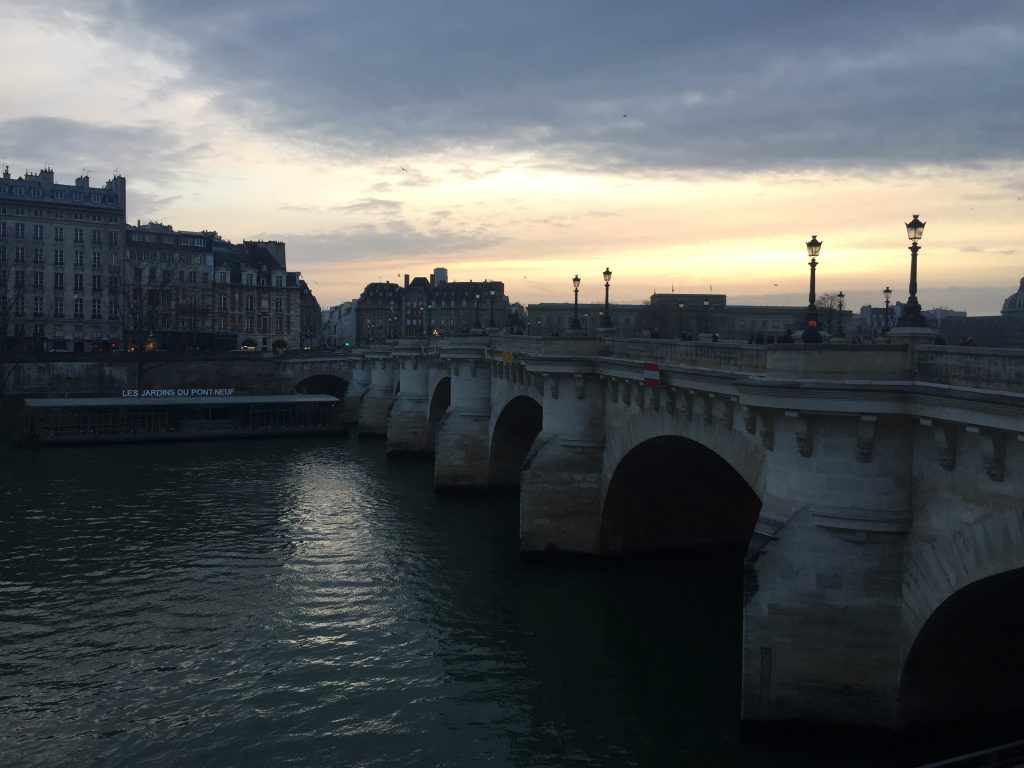
I elected to eat rather than have my teeth pulled out, however, and soon found a street overflowing with wonderful bistros with outdoor tables. I selected one that looked busy, with crowds of people spilling out onto the sidewalk. My table was the perfect spot to people watch for an hour or so while I tucked into a delicious Italian thin crust pizza and a glass of French Chardonnay. I was trying to replicate my late night adventure on the night I arrived in Sicily, and though this was much earlier in the evening it had the same vibe. From time to time a car would somehow manage to negotiate its way along the street forcing everyone in its path to dive into shop doorways.

What a lively place! The biggest craze in town appears to be the motorized scooters which can be rented from machines and then appear to be just left anywhere. These, and the ubiquitous bicycles are a nightmare for unsuspecting pedestrian tourists who rely so much on hearing a vehicle approach rather than seeing it.

My route back to the hotel took me past the glitter and glamour of the Rex cinema on the Boulevard de Bonne Nouvelle and then quite by accident I found myself at the Folies Berger but it appeared closed at this early hour. Anna had selected our hotel. It was fitting that as a family we had seen a live performance of Aida at the Roman amphitheater in Verona in 2000. Can that really be 20 years ago??? Each floor of this hotel was decorated differently and some intriguing lighting made the hallways look as if they were lit up by streaks of sunlight. Our room had splatter painted discs decorating the walls, and what I had taken for a mirror filling the entire wall turned out to be a TV! I only realized that when I discovered a remote control on the bedside table. My English speaking TV choices were between CNN discussing Trump and BBC world news getting their last little breaking news pieces about Brexit which will happen on Friday. I think Alan Beswick on Radio Manchester is much more entertaining night cap!
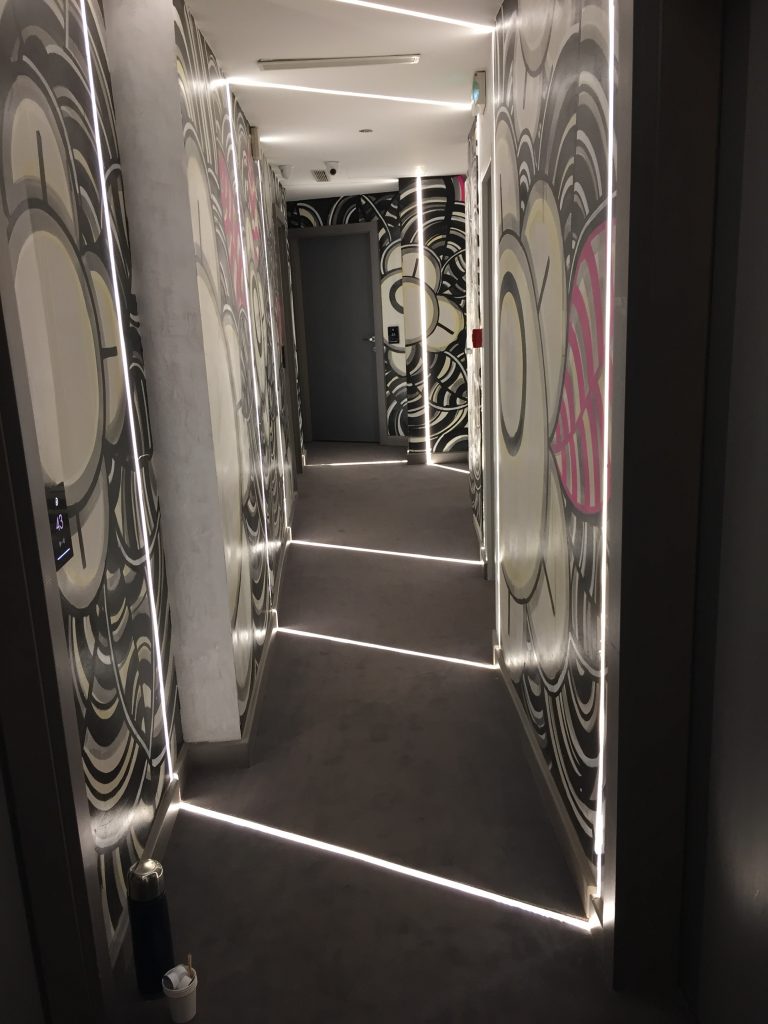
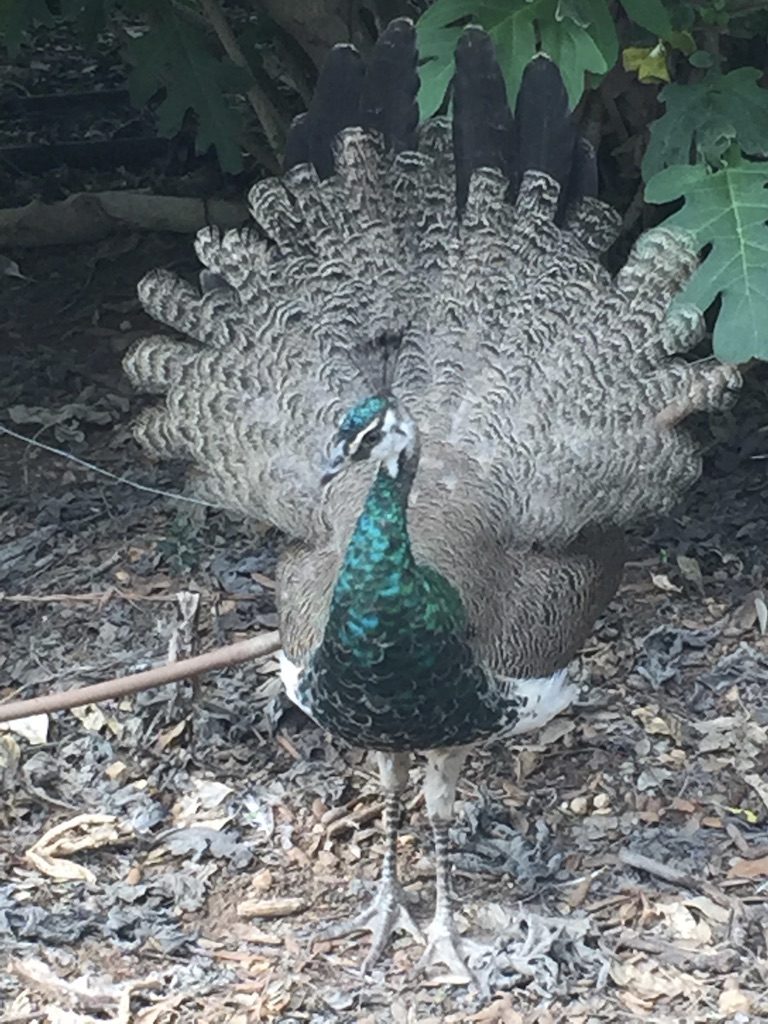
A lovely day for my final day in Malta. First port of call was costa’s famous basilica, famous for its survival after a bomb fell through the roof in 1942 but failed to explode. An Italian pilot was lightning his load and accidentally dropped it on the church but, as Maria quipped, since it was Italian in didn’t behave as it should have done, and failed to explode, fortunately since 300 people were attending mass inside the church. A replica of the bomb is on display – rather odd to see in a church. The Ro

man Catholic Church was built in 1833-1860 and is based on the Pantheon in Rome. Leaving the church we only were allowed 25 minutes to climb up to the balcony in the dome, visit the WW ll bunkers and/or get morning coffee.

I opted for the bunkers, just outside the basilica and saw reconstructions of the life that the people seeking safety lived. Lace making, hairdressing equipment and sewing machines were all part of life underground.

WWll bunker 
Then we were off to visit the San Anton Gardens in Attard. Because the towns in Malta are so densely populated every inch of land in the towns is taken up with building, apart from the few designated gardens which are open to the public. In fact apart from palm trees there are no trees on Malta and so there is no wood at all for building material.




Maltese kitty 
The gardens surround a palace that was originally built in the early 17th century and is now the residence of Malta’s prime minister. As I wandered around there numerous walkways I came to a gate manned by a soldier and at that moment a cavalcade of vehicles drew up and the soldier saluted. I guess the prime minister was in the car! The walled gardens were opened to the public in 1882 and it was lovely to see so much color in the flowers. I hadn’t realized until then how much I’d missed seeing colorful blooms. Of course the Maltese kitties were enjoying sunning themselves in the plant pots too. Several trees with the spiky and bottle-shaped trunks that I’d seen in Sicily were present and peacocks were strutting their stuff beneath them.

Lunch was at the coastal village of Marsaxlokk which is described as a typical fishing village, but the restaurants and street vendors have moved in and nowadays it’s a tourist haven too. Still, it was very very pretty with the traditional highly colored fishing boats and there were shoals of fish chomping on pieces of bread. Fishermen had their nets strewn along the quayside and on the menu for one outdoor restaurant, alongside the fried rabbit was octopus stew. I’d been holding out for a dish of mussels until I found a good place by the ocean so here was my opportunity since we were all free to find our own lunch.



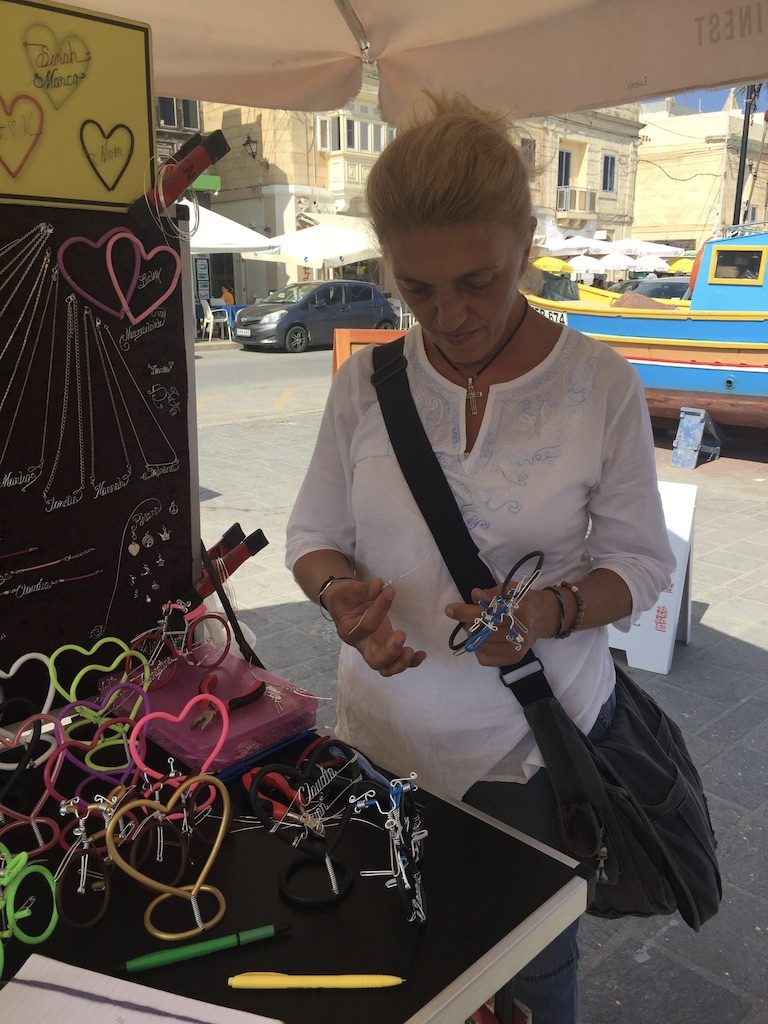


Doggies go for a sail 
We spent the rest of the afternoon on a tour of the three cities of Senglea, Vittoriosa and Cospicua whose fortifications were built by the Knights of St John. Streets almost narrow enough for people on opposite balconies to shake hands were the order of the day with peeling paint and weathered stone – just my sort of place. The week after I’d got back from my trip I saw a quote from L.S. Lowry in the Manchester Art Gallery: “I seem to have a strong feeling towards decayed houses in deteriorated areas ….” Preparations were being made for the Superleague Triathlon event the next day and tents, camera men and portable toilets and barricades were being set up along our route. In the church of St Lawrence in Valletta there were several clothed skeletons reminding me of the catacombs in Palermo.

Hmm . . . 

My favourite mural of the trip 

Our final dinner with the group was back in Sliema, at Piccolo Padre, a lovely ending to an interesting trip full of surprises.

The next morning I left Malta, bound for Leeds/Bradford airport along with another member of the group, and had a trouble-free trip back to Hebden Bridge where the all the colours of Autumn had come to the town in the week that I’d been gone.
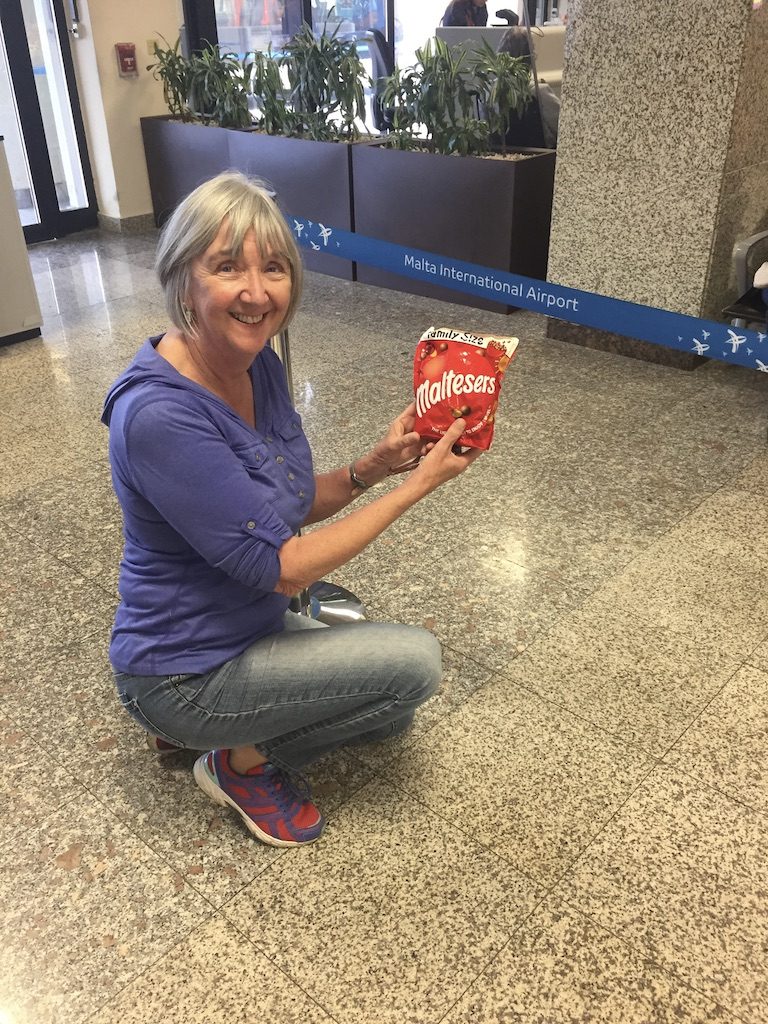
Just HAD to! 
Etna’s erruptin g




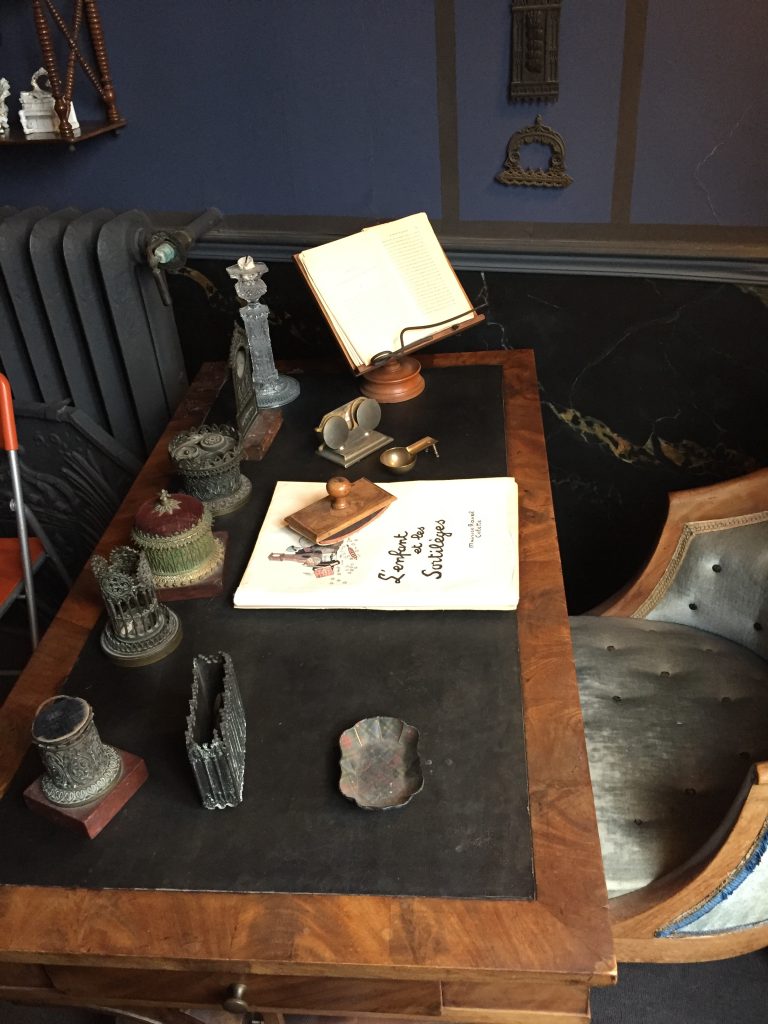


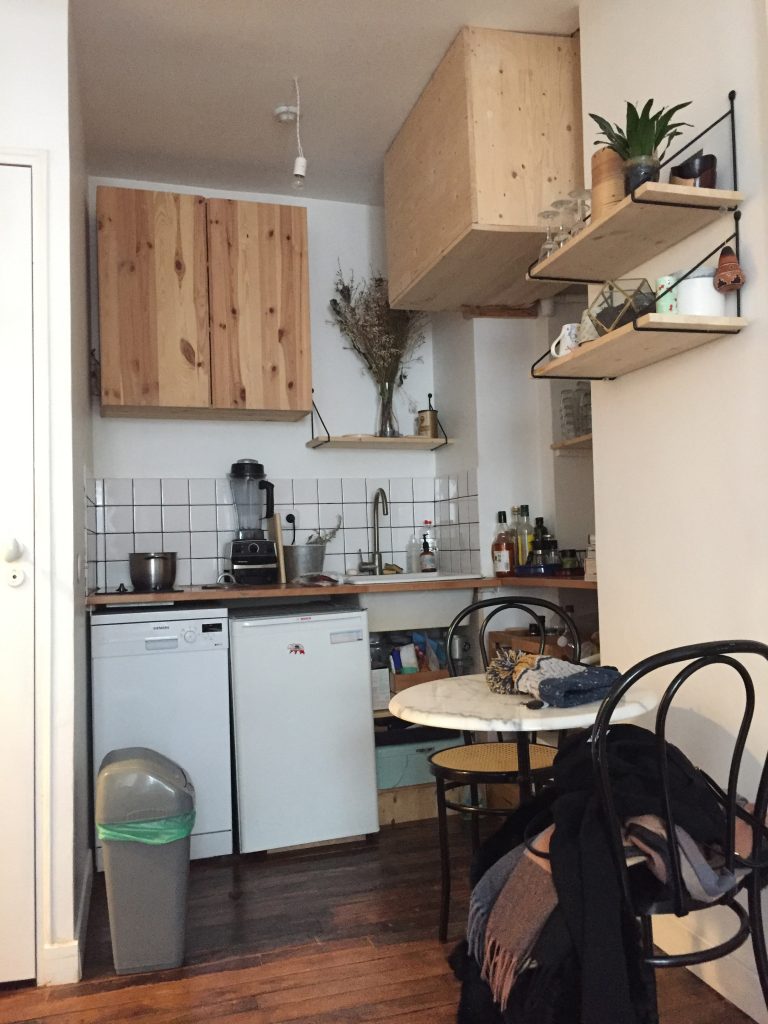
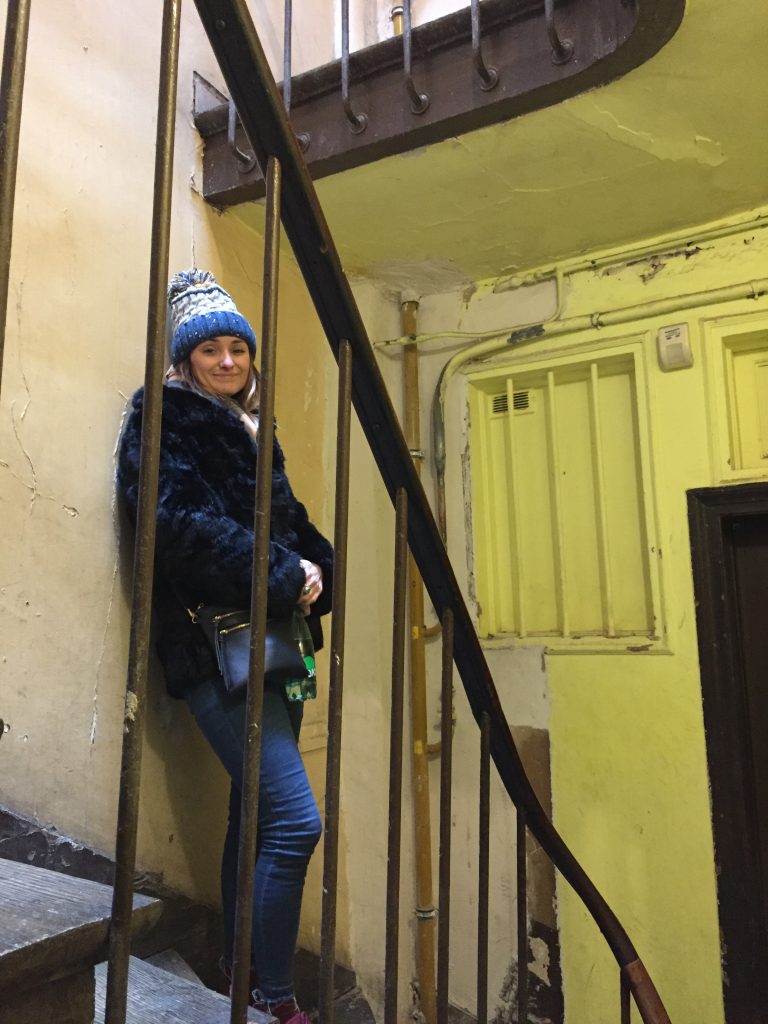

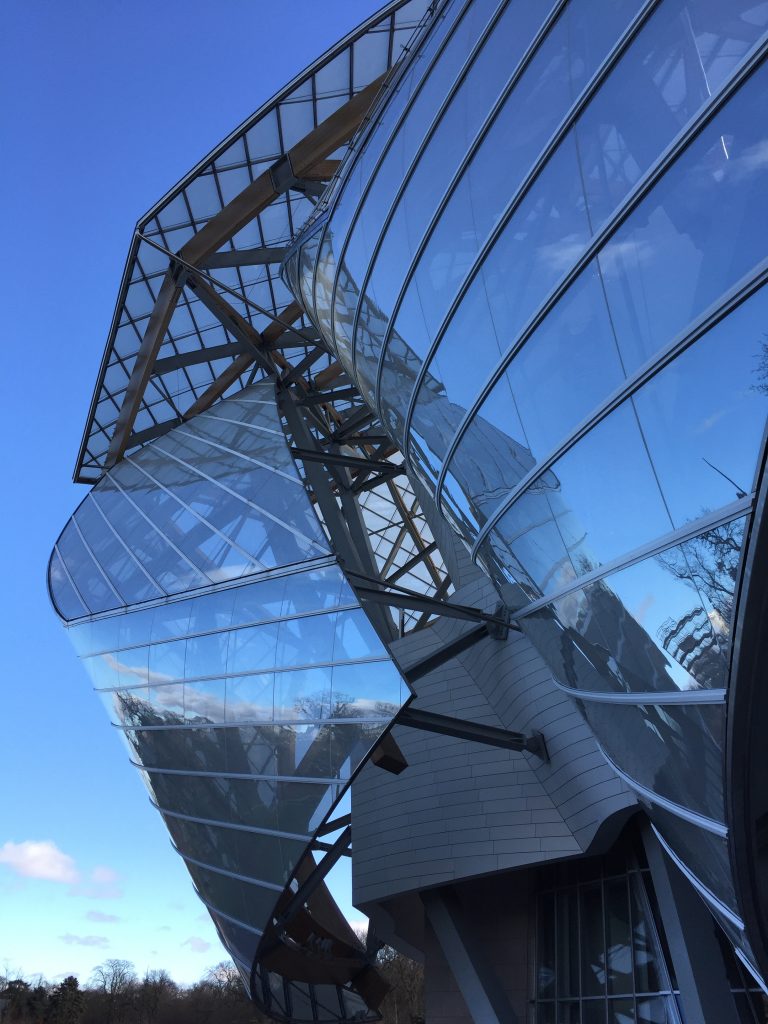

















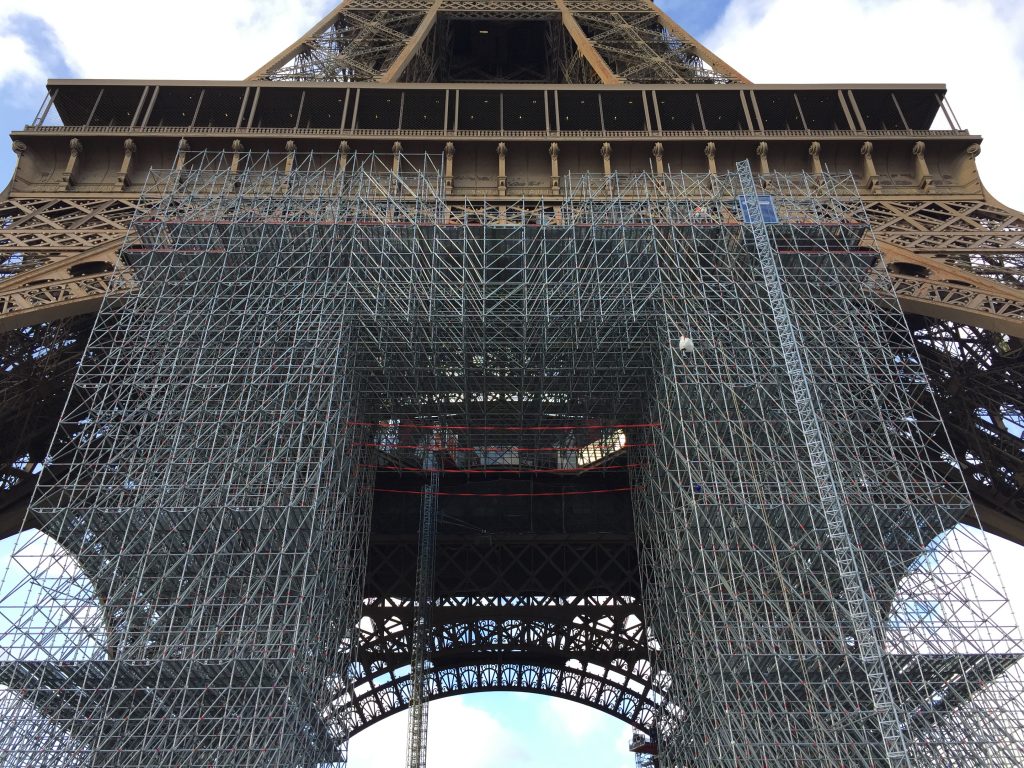





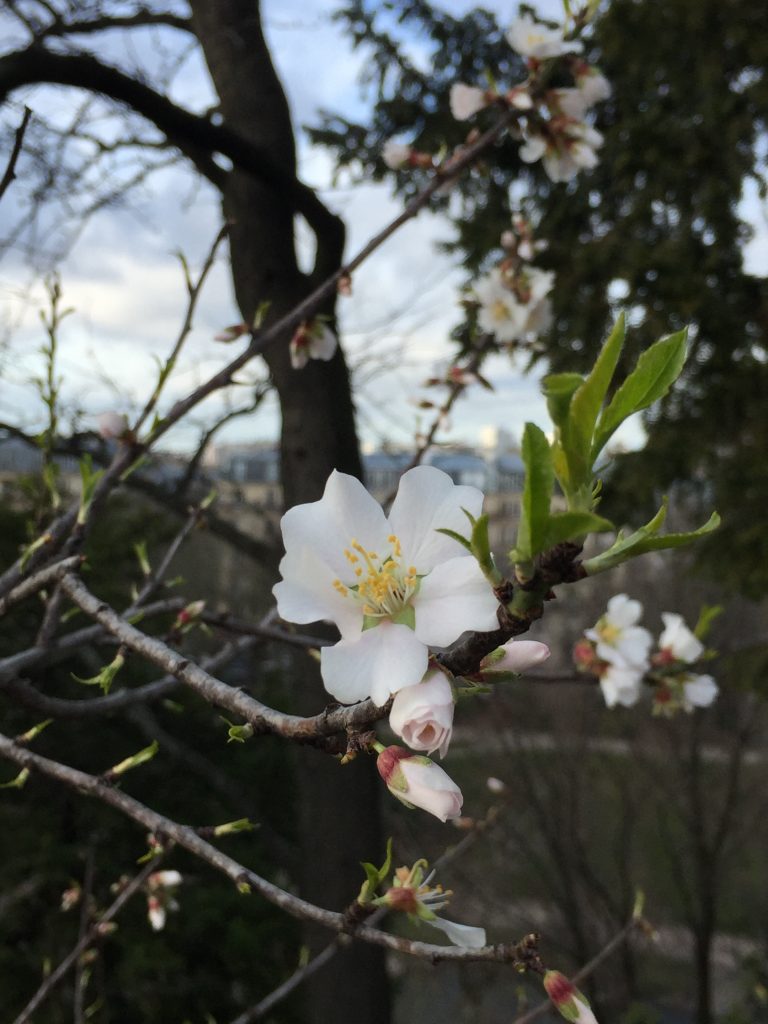









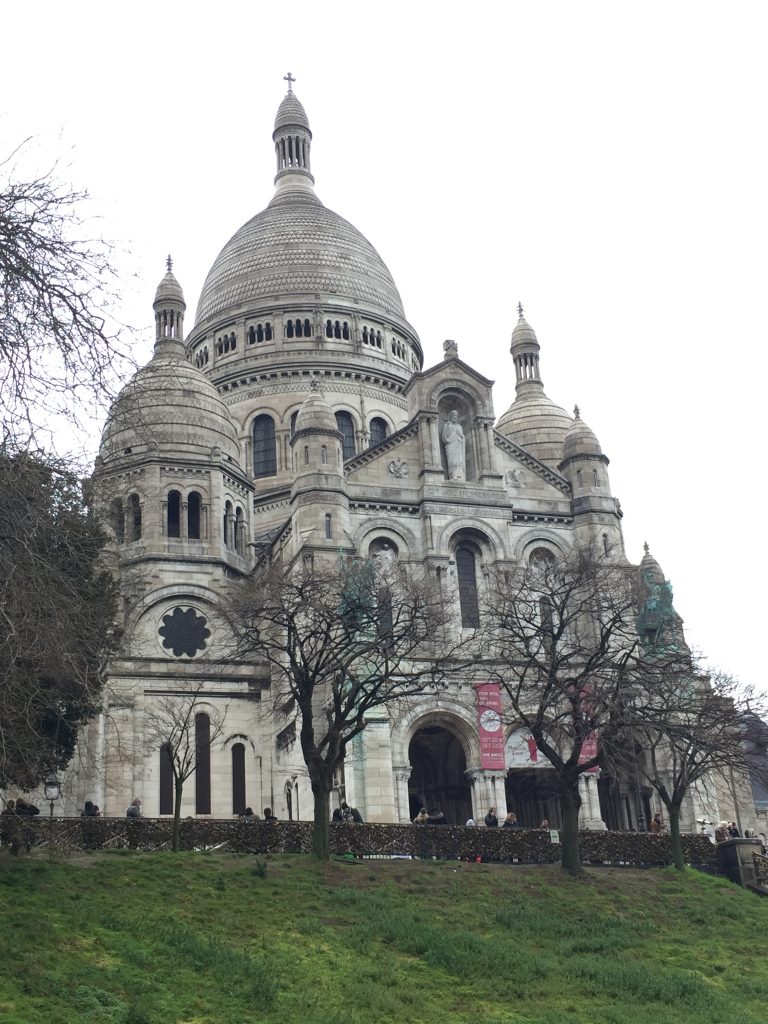

Recent Comments